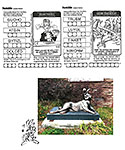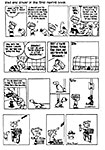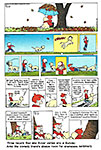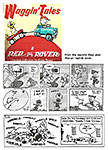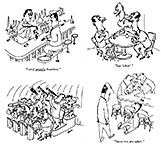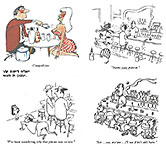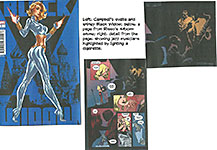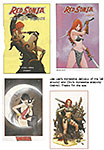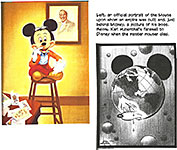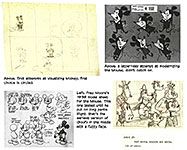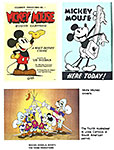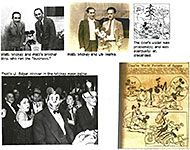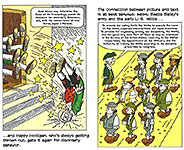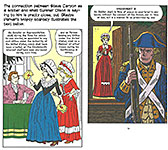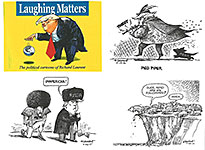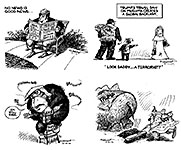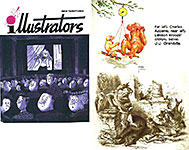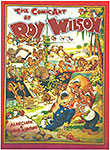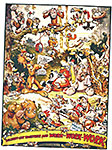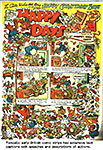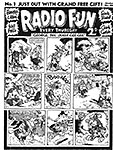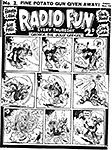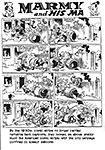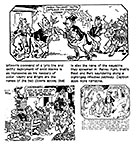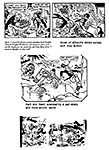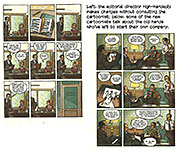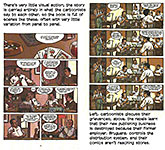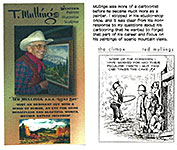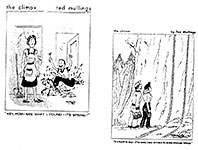 |
||||||||||||||||||||||||||||||||||||||||||||||
Opus 411 (news thru December 12, 2020). The survey of editoons in the last month includes post-Election editoons (Trump’s Big Sulk), plus we have articles on Stan Lee’s sad last days, the Victorian woman who created first comic strip, reviews of 8 books, 5 first issue comicbooks, 2 graphic novels, Tom Toles’ last ’toon and more. Here’s what’s here, by department, in order (the longest entries are marked with an asterisk* to help you decide where to spend your time)—:
NOUS R US Denver Cancels Next Year’s Con No More Free Holiday Peanuts Sack Wins the Berryman New Cartoonist on Andy Capp Pepe and His Creator Move On Scarlet Witch and the Vision To Stream on Disney+ Black Lightning To End Does DC Discriminate Racially? Origin of the Black Comics Collective Pence? A Cartoonist? More About Keef At the Movies: Tanquary Film Wins Emmy *First Comic Strip Was Created by Victorian English Woman *The Shortest Presidential Term: One Day
ODDS & ADDENDA Philip Guston Back on Schedule Record Sales of Comicbooks and Graphic Novels Ann Eisner Dies
FUNNYBOOK FAN FARE Origins No.1 Pantomime No.1 Year Zero, Vol.1, No.1 Goiter No.5 USAgent No.1
*STAN LEE’S SAD LAST DAYS Victim of Elder Abuse
Pat Byrnes Editoonist
THE BIG SULK And Other Trumperies
***EDITOONERY The Mock in Democracy Post-election Cartoons, Trump Not Conceding
TOLES’ LAST ’TOON
NEWSPAPER COMICS PAGE VIGIL Some of the Strange and Wonderful This Month
CARTOONIST GUEST APPEARANCES IN JUMBLE
ACCRETION OF INTENTION DEPARTMENT Older Books In Need of Reviews Red and Rover: A Boy, A Dog, A Time, A Feeling Also: Waggin’ Tales: A Red and Rover Collection Cork High and Bottle Deep (Cartoons by Vip)
RANCID RAVES GALLERY Lookin’ at Pictures Scott Campbell’s BlackWidow Cover Eduardo Risso Jae Lee’s Red Sonja
BOOK MARQUEE Short Reviews Of—: *Walt Disney’s Mickey Mouses: The Ultimate History Constitution Illustrated by R. Sikoryak Laughing Matters: Book of Laurent’s Political Cartoons Comics Aren’t As Simple As They Seem (Scholarly Treatise) *Illustrators No.29: Roy Wilson, Lawson Wood, Thomas Rowlandson, J.J. Grandville, and Charles Adams Editoonery Patrick Chappatte Does Graphic Novel
LONG FORM PAGINATED CARTOON STRIPS Graphic Novels The Winter of the Cartoonist Michael Jordan: Bull on Parade
Lyrics to Red River Valley
Passin’ Through *Ted Mullings
QUOTE OF THE MONTH If Not of A Lifetime “Goddamn it, you’ve got to be kind.”—Kurt Vonnegut
Our Motto: It takes all kinds. Live and let live. Wear glasses if you need ’em.
But it’s hard to live by this axiom in the Age of Tea Baggers, so we’ve added another motto: Seven days without comics makes one weak. (You can’t have too many mottos.)
And in the same spirit, here’s—: Chatter matters, so let’s keep talking about comics. AND—
“If we can imagine a better world, then we can make a better world.”
And our customary reminder: don’t forget to activate the “Bathroom Button” by clicking on the “print friendly version” so you can print off a copy of just this installment for reading later, at your leisure while enthroned. Without further adieu, then, here we go—:
NOUS R US Some of All the News That Gives Us Fits
DENVER CANCELS 2021 COMIC-CON In what may be the harbinger for comic-cons across the country next year, the May 2021 Denver Comic-Con was cancelled on December 7. The reason? Anxiety about the health threat of future large public gatherings. Nothing was said about planning for 2022. Called, lately, the Pop Culture Con, the event has been sponsored by an educational organization, Pop Culture Classroom, that offers programs in schools during the year. Most of the group’s funding, 90%, comes from its annual convention, reported the Denver Post’s John Wenzel on December 11. Said Adam Kullberg, interim executive director for the PCC: “We had to cancel in 2020, and uncertainty around large public gatherings isn’t going away anytime soon.” The 2020 con was initially planned for July 3-5; at first, it was postponed until November but then finally cancelled altogether. Most of the reason for cancelling was that its meeting venue, the city’s convention center, was being retrofitted into a temporary medical facility to handle increasing number of coronavirus cases. I’m not sure about the current state of the convention center, but PCC is in bad shape. “Without the planned revenue from the event in 2020—and now, 2021,” said Kullberg, “—we’ve been forced to eliminate staff positions related to the annual event [6 of 11 positions]. We’re shifting our efforts and staffing to focus on our core educational mission and will be providing as many opportunities for pop culture-based education, instruction, and creative community connection as we can in the face of a challenging public health environment and serious budgetary constraints.” Kullberg finished by asking “anyone who values the work we do” to donate to keep the program going, citing a website, popcultureclassroom.org/donate-2. That’s pretty serious. Reading between the lines here, cut-back in funding shouldn’t be the sole reason for cancelling all future cons. A dozen years ago, I met with the planning group for the first Denver Con, and no one was then getting paid. Preparations could go forward on the same basis now. No, I think it’s really Covid-19 and uncertainty about how large gatherings will operate in the future. Plus, there’s the retrofitted convention center. When will it become available for conventions again? Other comic-cons across the country may be facing the same difficulties and uncertainties. The nation’s largest, longest-running con, the San Diego Comic-Con International, probably has a pretty healthy bank account, so it ought not to experience the financial distress of the Denver Con. But it—and others—may cancel 2021's event simply because of the coronavirus. It may be too early to make such decisions. The vaccine, which is supposed to save us all, may be well on the way to producing herd immunity by the summer of 2021. Still, uncertainty about how all this might play out will make any planning activities in between now and late spring iffy. And in the land of the iffy, not much happens.
Here’s the First Time I Reported This News SAY GOOD-BYE TO PEANUTS ON TV For the first time in 50 years, “It’s the Great Pumpkin, Charlie Brown” did not air on broadcast network tv this year. Nope. No more free tv Peanuts. In mid-October, Apple TV+ announced an exclusive deal with Peanuts Worldwide, Lee Mendelson Film Productions and WildBrain Studios to become the home of all things Peanuts. Gone is the cherished family tradition of watching without charge Charlie Brown and the Peanuts gang celebrate holidays. From now on, you’ll need to be a paying subscriber to Apple TV+ in order to see the Peanuts troupe. That’s $4.99/month instead of free on a broadcast tv network. There are free viewing windows (I think that’s what the release in the current TV Guide said) on tv.apple.com, but the whole apparatus at Apple TV is a confused mechanism, seems to me. I just tried to sign up (which I think I did—for a free trial month) and it took me a half-hour. And I’m still not sure I’ve done it. (Well, I just checked, and I’m there—sure enough, a subscriber. For the free month.)
And Here’s the Footnote. Reacting to all the adverse hubbub, the Apple TV folks gave in and arranged for “A Charlie Brown Christmas” to be shown on PBS, Sunday, December 13. No charge. And there was a free window at Apple-TV+ December 11-13. But that’s probably not the end of the story. What will happen to the other Peanuts holiday shows we don’t know.
SACK WINS THE BERRYMAN Steve
Sack, longtime editorial cartoonist for the Minneapolis Star-Tribune,
has won the Clifford K. and James T. Berryman Sack’s winning cartoons offered indelible visual commentary on the Covid-19 pandemic, the fallout from George Floyd’s murder, the late Supreme Court Justice Ruth Bader Ginsburg, and the U.S. Postal Service during the 2020 election.
NEW CARTOONIST ON ANDY CAPP The dailycartoonist.com reports that Roger Mahoney, at age 87 and after about 65 years of cartooning, has retired from Andy Capp, which he has drawn since the 1998 death of the strip’s originator, Reg Smythe, collaborating with writer Roger Kettle. The strip is being continued by Lawrence Goldsmith, who draws Sean Garnett’s gags.
PEPE THE FROG HAS MOVED ON Matt Furie is a superhumanly gentle person said Sam Thielman at theguardian.com. He never wanted to be in the political limelight. “When we last spoke in 2016, just a few weeks before Donald Trump’s election, the artist was baffled by the ‘alt-right’ adoption of his creation Pepe the Frog, a chill amphibian who had become a notorious avatar for hate.” “He’s a frog, why would he support white supremacists?” Furie said at the time. “That doesn’t make any sense.” Over the last four years, Furie has patiently filed paperwork, attended depositions and met with lawyers to stop far-right figures such as InfoWars’ Alex Jones, Mike Cernovich, Richard Spencer and Tim “Baked Alaska” Gionet, from using his work to promote bigotry and cruelty. He won high-profile cases against people selling posters, books and merchandise using his beloved little frog, including Jones, who paid him a $15,000 settlement out of court. This is likely nowhere near the sum Furie has lost on Pepe merchandise that he feels he can no longer sell in good conscience, after the character was hijacked by extremists. In one scene in the recent documentary “Feels Good Man,” about Furie’s work to end his unwilling participation in rightwing meme culture, Furie is questioned by one of Jones’s lawyers. “So from 2001 to 2007, you had sort of this carefree, part-time, knucklehead life,” the lawyer, off camera, says. Furie, typically serene, answers: “I still have that. “Honestly, I haven’t really done comics in like a decade,” he says. “I’ve kind of moved on from it – it’s been haunting me. I liked doing it at the time, but I lost my mojo.”
MARVEL GOES BACK TO FIFTIES SITCOM SILLINESS ONCE AGAIN, Marvel superheroes took the cover of Entertainment Weakly, December 2020. The Vision and the Scarlet Witch, Wanda Maximoff. “After dominating the box office,” the headline reads, “—Marvel is ready to take over tv. Here comes ‘WandaVision.’” The
new tv show, debuting sometime this winter, takes its inspiration from beloved
tv sitcom classics of the 1950s, Designed for the soon to debut Disney streamer, “WandaVision” will run six episodes in its inaugural season, but Marvel hopes it will be just the pilot “episode,” so to speak, of a long-running tv dynasty. The studio is already hard at work developing seven additional shows, each one, like “WandaVision,” connecting explicitly with past and future big screen counterparts—“The Falcon and the Winter Soldier,” “Loki,” ‘Hawkeye,” “She-Hulk,” “Ms. Marvel,” “Moon Knight,” and “What If ...?”
BLACK LIGHTNING TO END WITH SEASON FOUR “Black Lightning,” The CW series based on the comicbook of the same name, will end after the upcoming fourth season. “When we first started the Black Lightning journey, I knew that Jefferson Pierce and his family of powerful Black women would be a unique addition to the superhero genre,” series developer and executive producer Salim Akil said in a statement. “The love that Blerds and all comic book fans around the globe have shown this series over the past three seasons proved what we imagined, Black people want to see themselves in all their complexities.” The news that the series will end next year comes just a week after The CW ordered a backdoor pilot for a potential spinoff starring Painkiller. Jordan Calloway, who stars as Painkiller/Khalil on “Black Lightning,” is attached to the potential series. Akil will write, executive produce, and direct the pilot. Other changes to the slate of DC show adaptations on The CW include the final season of “Supergirl” and the potential addition of a Wonder Girl series. [Oh—and, a “Blerd” is a Black nerd.]
DOES DC DISCRIMINATE RACIALLY? Harvey Richards and Lateef Ade "L.A." Williams, two Black former DC Comics editorial staffers, told Business Insider they felt their careers at the company were hindered because of their race, reported Travis Clark. Richards was fired in December 2019 after 22 years and was the only Black editorial staffer at DC when he left. He was only promoted once. Williams exited in 2000 after six years without a promotion and after disputes with white members of DC leadership. The careers of Richards and Williams cut across two decades, but the similarities in their experiences, from being told they'd never be promoted to a feeling that their achievements were not valued, show how little has changed for Black staffers. DC's small editorial team shapes the comics that inspire lucrative movies, video games, and merchandise. Richards and Williams said that it's important for Black editors at DC to be in a position to champion diversity. The similarities in their DC careers are striking and speak to how little has changed for Black editorial staffers at DC Comics and in the comics industry at large. Richards was the only Black staffer in the main DC editorial department at the time of his exit in 2019, which included about 15 people, he said. He added that DC has since hired a Black assistant editor. DC declined to comment on personnel matters.
THE ORIGIN OF THE BLACK COMICS COLLECTIVE By Ian Thomas For over twenty years, Deirdre Hollman has espoused the study of Black history, art, and culture to students and teachers, alike. In her fifteen years as Director of Education and Exhibitions at the Schomburg Center for Research in Black Culture, Hollman programmed public lecture series for adults and exhibitions of the Schomburg’s collections for youth and teens through learning partnerships with schools and community organizations. In this capacity— with comics scholars John Jennings and Jonathan Gayles and cartoonist Jerry Craft— she co-founded the Black Comic Book Festival at the Schomburg Center in 2013. Then in 2017, following her time at the Schomburg Center, Hollman launched The Black Comics Collective which “celebrates cultural diversity in comics and seeks to amplify awareness of creators, writers, illustrators, and publishers who are producing independent comics that depict a dynamic range of global Black experiences, aesthetics, and social issues in both earthly and other-worldly realms.” In practice, this celebration takes many, many forms: meet-ups, talks with creators, conventions, book-festivals, film screenings, and exhibitions. Hollman’s methodology is rooted in afrofuturism, a cultural aesthetic that situates itself at the intersection of African diaspora culture and technology. She is effusive in her praise of work that meets this criteria. Because she speaks so eloquently on the value inherent to these works, and their creators, her enthusiasm is infectious. Hollman has a seemingly boundless optimism for the potential of Black Comics Collective to bring Black comics and culture to new audiences and empower the people creating work, at any level, in this vein. Hollman is currently pursuing an advanced master's and doctoral degree in education at Teachers College, Columbia University. She recently moderated a panel, “Back to School with Black Comics and Graphic Novels,” for the Schomburg Center Literary Festival, conducted virtually this year. Ian Thomas spoke with her in late September of 2020. The foregoing is preamble to the interview, all of which is posted at tcj.com
I’LL BE DARNED: PENCE WAS A CARTOONIST In
the mid-1980s, while attending Indiana University’s Robert H. McKinney School
of Law, Vice Prez Mike Pence drew a regular comic strip for the school
paper, Dictum. The strip, reported Carey Dunne at hyperallergic.com,
called Law School Daze, stars Pence’s alter ego, a quivering,
incompetent wreck of a law student. (Pence, who graduated in 1986 with a “B” Earlier this year, Indiana University released a series of Pence’s comics. Said Dunne: they’re full of bad law puns (i.e. a fictional magazine called “Torts Illustrated”) and spelling errors (“wierdest,” “bumbed out”). Perhaps the strangest comics are those that seem to reflect a degree of self-awareness on Pence’s part — in particular, a drawing of an auctioneer at the Women’s Caucus, offering to pay the audience to take original Pence drawings off her hands. “It suggests,” said Dunne, “Pence knows the women’s movement hates him, and that his cartoons are bad, and also that, unfortunately, he doesn’t really care either way.”
MORE ABOUT KEEF Harvey Award-winner Keith Knight has been creating his comics for print and online outlets since the early 90s, said ICv2.com, with collections released from a variety of publishers as well as self-publishing.Then “Woke,” the new tv series he inspired and co-wrote about a Black cartoonist whose life is changed by an encounter with the police, has dropped on Hulu. In a year defined by Covid and by the reckoning with racial justice issues brought to a head by the police killing of George Floyd, the timing of “Woke” seems tailor-made for 2020, but Knight's been raising the same issues throughout his career. Knight is many things to many people— rapper, social activist, father and educator among them. He’s also one of the funniest and most highly regarded cartoonists in America, and the creator of three popular comics: syndicated strip The Knight Life, single panel editoon (th)ink, and multi-panel The K Chronicles. Knight is part of a generation of African-American artists who were raised on hip-hop, and infuse their work with urgency, edge, humor, satire, politics and race. His art has appeared in various publications worldwide, including the Washington Post, Daily KOS, San Francisco Chronicle, Medium.com, Ebony, ESPN the Magazine, L.A. Weekly, Mad Magazine, and the Funny Times. Online at ICv2.com is a video of PW Senior News Editor Calvin Reid talking with Knight about his comics, the ways he's reached his audience, how that led to the show, and what he's planning next.
AT THE MOVIES: “HAND DRAWN” WINS AN EMMY And a Personal Note “Hand Drawn Life,” Tom Tanquary’s 90-minute documentary on the history and influence of the American newspaper comic strip, has won a couple of awards so far (with, presumably, more in the wings). The first award was an Emmy for Best Independent Film from the Los Angeles Chapter of the Academy of Arts and Sciences. It also won Best Feature in the Chagrin Documentary Film Festival. In addition, it was selected to be screened at last summer’s International Comic-Con at San Diego, and it was officially entered in the competition for an Eisner Award. When the Con was cancelled due to the plague, both of these plans went into limbo. Presumably both will be held over until the 2021 Comic-Con. Assuming there is one. It’s entirely Tom’s film, the culmination of one of his fondest wishes; as a comic strip afficionado and freelance award-winning documentarian (who usually works at NBC), he’s wanted to do this film for years. I acted as a sort of shill, interviewing a couple dozen cartoonists to get them to talk about their work and the comic strip genre, and Tom filmed the conversations. I once estimated that Tom had over 2,000 minutes of interviews. Exercising an acute sense of his vision for the finished product, Tom edited it mercilessly to 90 minutes, adding, in the process, footage depicting significant or historic comic strips (and a few feet of me expounding). It was great fun to do— flying all across the country to interview people like Jules Feiffer, Lynn Johnston, Mort Walker, Greg Evans, Morrie Turner, and so on. Took an hour or two with each one. And Tom and I became good friends. He even gave me a ‘with.’ The byline says ‘A film by Tom Tanquary with R.C. Harvey.’ Tom hopes it will be picked up by PBS nationally. If you’d like a DVD of the film, drop me a note with your snail address, and I’ll send you one. There’s a link to my e-mail address at the end of this Opus (where it says “Send e-mail to...”).
THE FIRST COMIC STRIP Was Created in Victorian England by a Female Artist Comic artistry is an area often perceived and marketed as primarily male, said Ana Olendraru at bluestocking.org.uk. Popular media presents comic books and their characters as a form of art addressed to young boys or to the stereotypical ‘loveable nerd,’ most often a man. “It might then come as a surprise to many that one of the trailblazers in graphics, picture-making, and comics was Marie Duval, an illustrator working for a two-penny magazine in Victorian England.” The character of Ally Sloper, the ruddy-cheeked, tulip-nosed, working-class man doing his best to escape his creditors, first appeared in Judy magazine under the hand of Charles H. Ross. Ally Sloper was discontinued but reappeared a few years later with new attributes, new companions, and weekly adventures, reaching unparalleled popularity. Although the feature was still attributed to Ross, Ally Sloper’s new persona was now created and illustrated by Ross’s wife, former actress Marie Duval who signed all her drawings ‘MD’ or ‘Marie Duval.’ The depiction of a working-class character who tries his best to make money by doing the least work possible further distinguished Duval from her male and female counterparts as she became a satirist of the Victorian work ethic. Duval depicted Ally Sloper in ragged clothes with a nose flushed with drink and whose weekly adventures focused on cheating his creditors. Being at once lazy and unsatisfied with his status, but oftentimes jolly, sympathetic and pictured as being justified by his circumstances, Ally Sloper defied stereotypes of the working-class.
Duval’s notion of institutionalized cheating that may later have inspired Charlie Chaplin’s Little Tramp character and W.C. Fields: because the working-class is constantly cheated by the upper-class, it survives by cheating it back. Thus, Duval’s Ally Sloper adapts to the system he is forced to work in by attempting to take advantage of it; the inspiration is visible in Chaplin’s character, who breaks windows in order to be paid later to fix them in “The Kid,” combining humor with criticism of societal norms. The success of this humorous but nonetheless powerful rejection of the bourgeois model of the working-class is proved, saith Olendraru, by the fact that Ally Sloper reached popularity among a mainly working-class audience. Olendraru continues: caricature, and journalism in general, was a male-dominated field in Victorian England as “women’s nature” was considered antithetical to the “aggressive polemical and critical nature of so much journalism in general and caricature in particular” (according to David Kunzle). It is in this context that Marie Duval laid the foundation for comic strips as we know them today. Although long-denied to her, she is now given credit for the development of the first regular continuing comic strip and cartoon character in England to attain an unparalleled level of popularity (it was later commercialized and appeared on snuffboxes and doorstops) and for the expansion of the language of graphics in the 20th century. Fitnoot: Here at Rancid Raves, we recognized Marie Duval’s contribution to the cartooning arts as far back as Opus 348 in February 2016. So there. Incidently, the character’s name derives from English slang: “to slope” means to escape surreptitiously; an “alley sloper” is one who escapes paying rent by slipping out the back door and running down the alley.
THE SHORTEST PRESIDENTIAL TERM The Trumpet’s refusal, so far, to concede the election to Joe Biden creates all sorts of hysterical fantasies in the minds of historians as they contemplate what might happen should Trump never concede. Will he continue to be Prez? Heavens no: the presidency is determined by election not by concession. Biden will be Prez no matter how long Trump sulks. But the odd circumstance brings to mind another odd piece of presidential history—namely, the shortest term ever served in the office. It lasted just a day. It was in 1849. In those days, the inauguration of a newly elected Prez took place on the 4th of March, not the 20th of January. President James Polk’s term expired at noon March 4, but newly elected President Zachary Taylor refused to take the oath of office on the 4th because it was a Sunday. A pious man, Taylor didn’t think he should do anything on the Sabbath, let alone swear any oaths. As a matter of record, Taylor and his Vice Prez were sworn in at noon on Monday, March 5. So who was Prez for the 24 hours between noons? As a matter of law (the one instituted in 1792), the third person in the line of succession to the Presidency—after the second, the Vice President—was the President Pro-Tempore of the Senate (i.e., the “chairman” of the Senate). On March 4, 1849, the President Pro-Tempore was David Rice Atchison. He had been elected Pro-Tem the day before, March 3, and, according to the legend I’m unveiling here, he’d gone out to celebrate his election that evening, and he’d consumed several quantities of adult beverage during the festivities. After that, he went home to sleep it off, and he slept until sometime Monday morning. At noon Monday, Taylor took the oath and became Atchison’s successor as Prez. In other words, Atchison spent his entire Presidency sleeping off the after-effects of a drunken night of celebration. When interviewed by his hometown newspaper, Atchison said (in italics): “It was plain that there was either an interregnum (a time when a country lacks a government), or I was the President of the United States, being chairman of the Senate, having succeeded Judge Magnum of North Carolina. ... I made no pretense to the office, but if I was entitled in it I had one boast to make: that not a woman or child shed a tear on account of my removing anyone from office during my incumbency.” He also called his presidency “the honestest administration this country ever had.” Presidential scholars refute the notion that Atchison was ever Prez, even for the 24 hours of legend and history, March 4-5, 1849. But not everyone is a presidential scholar. He stayed in the Senate and was elected President Pro-Tempore thirteen times. When he left the Senate, he joined the Confederate army during the Civil War. He died in 1886 at his home near Gower in Clinton County, Missouri. More than 40 years later, a statue of Atchison was unveiled in front of the town’s Clinton County Courthouse; it bears a plaque declaring him “President of the United States for One Day.” Less than a mile away, a marker with a similar inscription lies atop Atchison’s grave in Greenlawn Cemetery at Plattsburg. So Atchison hasn’t been forgotten There are no monuments to him in the National Mall and his face does not grace any currency, but his legacy endures. The town of Atchison, Kansas—which in turn lent its name to the Atchison, Topeka and Santa Fe Railroad—was named in his honor, and the Atchison County Historical Society Museum hosts the David Rice Atchison Presidential Library, which bills itself as “the world’s smallest presidential library.” The Trump legacy cannot possibly compete.
ODDS & ADDENDA The much-discussed Philip Guston retrospective will now open in 2022, said a spokeswoman for the National Gallery of Art in Washington, after the announcement last month of a delay until 2024 sparked a backlash in the art world. Calvin Reid at publishersweekly.com reported that combined sales of graphic novels and comics periodicals reached $1.21 billion in North America in 2019, a new record, according to a joint estimate by trade news sites ICv2 and Comichron. Diana Schutz reported that we lost Ann Eisner on November 13. “We used to joke that Will would live to be a hundred, but it was Ann who really gave that a run for the money,” Schutz said, adding, “I believe she must have come to say goodbye, because I woke up this morning thinking of her, before I learned she was gone.”
Fascinating Footnit. Much of the news retailed in the foregoing segment is culled from articles indexed at https://www.facebook.com/comicsresearchbibliography/, and eventually compiled into the Comics Research Bibliography, by Michael Rhode, who covers comic books, comic strips, animation, caricature, cartoons, bandes dessinees and related topics. It also provides links to numerous other sites that delve deeply into cartooning topics. For even more comics news, consult these three other sites: Mark Evanier’s povonline.com, Alan Gardner’s DailyCartoonist.com (now operated without Gardner by AndrewsMcMeel, D.D. Degg, editor); and Michael Cavna at voices.washingtonpost.com./comic-riffs . For delving into the history of our beloved medium, you can’t go wrong by visiting Allan Holtz’s strippersguide.blogspot.com, where Allan regularly posts rare findings from his forays into the vast reaches of newspaper microfilm files hither and yon.
FURTHER ADO Professional pollsters “blew it again,” said Matthew Rozsa in Salon.com. They predicted an easy victory for Joe Biden; instead, he won by a hair (well, a little more than that; but still...). Some polls had Biden ahead by as much as 10 percentage points; the final margin is probably 4-5 percentage points. Pollsters predicted a 3-6 point Biden victory in Florida and a toss-up in Texas; Trump took Florida by 3-plus and Texas by almost 6. After a similar fiasco in 2016, pollsters tried to capture more potential Trump supporters by weighting for rural voters and those without four-year college degrees. But the correction may have been “insufficient” and failed to compensate for the deep distrust many conservatives feel for the mainstream media and polling outlets. They may be hanging up on polling calls “in disproportionate numbers.” Whatever the case, polling faces an “existential threat,” said David Graham in TheAtlantic.com. And the damage can be vast. Much in American democracy depends upon polling: lawmakers make laws that reflect what polls show Americans are thinking and believing about various issues. If everyone decides polls can’t be trusted anymore, “we’re flying blind.”
FUNNYBOOK FAN FARE Four-color Frolics An admirable first issue must, above all else, contain such matter as will compel a reader to buy the second issue. At the same time, while provoking curiosity through mysteriousness, a good first issue must avoid being so mysterious as to be cryptic or incomprehensible. And, thirdly, it should introduce the title’s principals, preferably in a way that makes us care about them. Fourth, a first issue should include a complete “episode”—that is, something should happen, a crisis of some kind, which is resolved by the end of the issue, without, at the same time, detracting from the cliffhanger aspect of the effort that will compel us to buy the next issue. A completed episode displays decisive action or attitude, telling us that the book’s creators can manage their medium.
ORIGINS No.1 is a gorgeous book. Jakub Rebelka paints with color, and his paintings create a world in ruins. Without his paintings, we might not be convinced that the world we—all of us readers—live in has been destroyed, familiar landmarks—the Brooklyn Bridge, Statue of Liberty Island, New York City—have crumbled and are now overgrown with wild shrubs and other weeds. Clay McLeod Chapman’s story is carried, at first, in caption blocks that float across the decayed landscape. “David” is one of the narrators. Evidently a young person, he wants whoever he’s with to tell him a story. And so she does—the story of how she found him and rescued him, hiding him away from harm. The accompanying pictures tell us that David, when found, was an infant. The book’s narrative is divided into three parts: Then, Now, and Then again. The story of David’s being found and rescued is in the first Then. In Now, David is a grown-up youth, and he’s traveling with Chloe, a blonde woman. They both wear some kind of body armor. They walk through a tangled forest, and David finds some strawberries—which turn out to be booby-trapped. Luckily, he drops them before they can do any damage. This episode shows Chloe to be wise and watchful; David, curious and quick. They are attacked by a prehistoric-looking bird. Chloe kills it, saying that the Network now knows where David is. They visit New York’s natural history museum, and while strolling its halls, David announces that they must do “the upload,” but Chloe resists the idea, saying that David has no idea what it will reveal about him. Is he ready? But this episode shows David to be determined to do what must be done. And together, these two episodes show that the storytellers can manage a cohesive story without sacrificing suspense. And vice versa. Next,
the narrative shifts quickly to Then for the last two pages, where we see David
as an infant again. Another The book is borderline mysterious with too few recognizable elements. We realize that the world has been nearly destroyed. Somehow. We get the idea that perhaps David is to be its savior, and that something called the Network threatens him. The book succeeds in creating likeable lead characters and a menacing mysterious atmosphere. But it’s Rebelka’s gorgeous pictures that will bring me back.
IN PANTOMIME No.1, we meet Haley and her brother Max. Their mother has just died, and their father, usually absent, has walked away and left them in a home for children with special needs: they’re all deaf and communicate with sign language. Dunno why writer Christopher Sebela chose this awkward characteristic for his cast; every time one of them utters a word, we see him or her gesturing with fingers and hands. David Stoll has invented a visual way of conveying that the characters are talking by having the tail of speech balloons point to hands instead of mouths. To further complicate the situation, Haley is the story’s first-person narrator. Thankfully, she talks to us in captions, not sign language. Haley and several of her friends decide to burglarize one of the school’s instructor’s office in order to get back something he has taken from one of them. That adventure is successful, and the kids, excited by their daring and success, decide to commit another robbery. This time, they break into a rich man’s home. Again, they seem successful. And then— Haley and Max enter the school office, where they find the man whose house they robbed, standing over the cowering figures of their fellow juvenile burglars. The man says:
End. Nice cliffhanger. Stoll’s artwork is entirely adequate, distinctive but without appeal. Since I buy comicbooks based upon the visuals, I’m not likely to get the second issue of Pantomime. But that’s my problem, not Stoll’s or Sebela’s. Nearby are a couple pages so you can see (and decide) for yourself.
I DON’T KNOW HOW MANY issues Year Zero took to complete Volume 1, but now we’re up to Volume 2, No.1. As before, Benjamin Percy’s story comes at us in four distinct venues. One stars Hallie Ragnar in Norway; she’s in the ocean fishing business and encounters zombies. In Colombia, El Topo is a bored crime boss. Tina Pumper is trapped alone at night in a superstore in Phoenix, Arizona. And in Rwanda, Ishmael Achebe is running in fear. Hallie
is away from civilization, and she’s threatened by “the gods”—armed men. Topo
goes a-killing. Tina vomits. And Ishmael is a doctor on the run. Each of these
3-page episodes demonstrate writer Percy’s command of the medium with a story
that is incomplete in four installments. And Juan Joseryp’s artwork is
impressive—detailed, realistic. At the end of the book, Percy explains his purposes: “The design of the series continues to be global. If The Walking Dead was a story experienced through a microscope—following a ragtag band of survivors—then Year Zero is telescopic by comparison. Expansive. Sweeping in its gaze.” Hence, the four locales. Percy goes on: “Our characters are a cross-section of humanity. ... We live in a time of fear and confusion. Forest fires blaze. Hurricanes batter coastlines. Protestors and police clash in the streets. We don’t know how to process the news when politicians lie, when seemingly invincible athletes die in helicopter crashes, when comedians and movie stars and producers turn out to be predators. All this time, an invisible enemy is moving among us. ... “So there’s something morally clarifying—and even comforting—about a zombie story, right? Here is an indisputable bad buy, a known evil. ... But of course no horror story is merely about the monster. Whether it’s a vampire or a werewolf, a giant ape or giant shark, a ghost or a zombie—the monster is an analogue to whatever trauma or weakness your protagonists are wrestling with. ... “The first volume of Year Zero showed us the end. But this second instllment follows a new beginning, as characters learn how to carry on and build new lives for themselves— something we can relate to all too well.” So now we know. Now, I have to go back and get the rest of Volume 1 before I can continue with this volume, Volume 2.
THE LONGEST STORY of the three in Josh Pettinger’s Goiter Comics No.5 is about William Cucumber in “The Lake.” William, a thoroughly lifeless nerd, lives with his parents and works on the beach, renting beach chairs, a job that doesn’t pay him enough that he can afford an apartment. He comes home one day to discover his room has been cleaned out, his belongings all packed up. His parents are divorcing, and his mother’s new husband is moving in with his daughter, who will take William’s room. William has no luck in finding an apartment he can afford. He starts living in a tent in the backyard of his mother’s home. His beach chairs are being stolen. Dead broke, he signs up for a medical experiment in cigarette smoking. One morning, his stepfather’s daughter Laura comes to him to complain that his weeping in the tent at night annoys her. Laura suddenly announces that her father is a murderer. William joins her in looking for incriminating clues. They find nothing. Laura sneaks up behind William and hits him with a potted palm. She drags his body to a cliff and throws him over it. He wakes up in the water, floating on a pile of beach chairs. Bruce Walker floats by in an inner tube. We don’t know who Bruce Walker is, but William had planned to write a screenplay for him. Walker floats away, leaving William stranded on the pile of beach chairs. That’s it. The
most distinctive thing about this comicbook is the artwork, which is so bad
it’s painful to look at it. The book is as sterile a visual as its story is
meaningless. But Pettinger is conscientious: he puts in every necessary detail,
however blandly rendered. The other two stories are much shorter. They are also about losers for whom life is meaningless mere existence, grim and joyless. One story, two pages long, is entitled “Tussle.” In it, a man offers to buy another man’s horse for enough to enable the second man to buy two horses. Then he offers to tussle the horse-owner for the horse. He wins. The other man’s wife shows up and tells him she’s leaving and taking the children with her. He says: “You probably don’t want to tussle for them, do you?” She leaves him just standing there. None of the characters have a goiter.
IN USAgent No.1, we meet a would-be Captain America. John Walker dresses like Cap, but falls somewhat shy of his idol in combat. No First Name Priest’s story begins with a series of talking heads, complaining about the joblessness following the closing of the local coal mine. And then they continue to complain about the new power plant because it didn’t hire local help. None of which has anything to do with the pizza guys. When the first pizza guy shows up delivering pizza, Walker, holding a gun on him from inside the house, forces the pizza guy to come inside, where he’s locked up in the basement—with some other pizza guys. We expect the same treatment for the second pizza guy, but he proves to be a wise guy and outsmarts our USAgent. Then, in the ensuing fisticuffs, the pizza guy beats USAgent all over the place. Then they declare peace. In locking pizza guys up, USAgent was protecting them because he suspects that someday some pizza box will have a bomb in it. When the next pizza guy drives up, USAgent yanks him out of the car but is prevented from doing any damage by a gaggle of worshipping kids who are watching him. Next, he and the wise-ass pizza guy get into a flying machine and go streaking across the sky until they’re shot at. Then USAgent climbs on a motorcycle that he had stashed in his flying automobile and, with the pizza guy clinging to his back, goes racing off in the direction of some uniformed and masked bad guys, one of whom strips off the mask, revealing a beautiful woman who says, “Hello, Johnny” to USAgent. To which he responds, “Hey, sis.” End. In short, this is a comedy, a spoof of superheroing. So far. Georges Jeanty on pencils and Karl Story with ink make great pictures—good action sequences and a great comedy sequence with the second pizza guy at the door, out-smarting USAgent. And they’re great on facial expressions, which, in some sequences, carry the comedy. But I can’t tell where this thing is going.
Plenty of completed episodes demonstrating the storytellers’ command of the medium, but what is all that early stuff about coal mines and power plants? Is that just to create a serious, threatening situation so USAgent’s subsequent fooling around will seem more inappropriate and therefore comedic? Hard to say based upon this single issue. And because it’s hard to say, this book fails as a first issue. Too bad. The pictures are pretty. And that’s the best thing about this book.
QUOTES & MOTS When asked about Trump's false claims of fraud and refusal to concede the election, a senior Republican official said, “What is the downside for humoring him?" That's like saying, "what's the downside of giving a pyromaniac a two-month supply of matches and lighter fluid?"— Rob Rogers
STAN LEE’S SAD LAST DAYS In April, 2018, a video appeared on YouTube, recorded on a cellphone at the Silicon Valley Comic-Con, where Stan Lee was a star attraction. In the grainy video, the 95-year-old Lee [is poised to sign a comicbook but] appears unable to sign his name. Which is important to note because Lee and his handlers were there to sell his signature for $120 a pop. A dark-haired man in his forties, dressed like an MTV gangster in a black skinny suit, black fedora and sunglasses, coached the barely cognizant Lee through the task. The man, later identified as Lee’s former business associate Keya Morgan, spoke to Lee as if he were a child, schooling him on how to spell his name: “Stan Lee—S-T-A-N ....” Morgan spelled it out again and again as comicbook after comicbook was slipped in front of the white-haired Lee. These two paragraphs begin an article in the October/November issue of the AARP Magazine. Entitled “The Last Days of Stan Lee,” the article is written by David Hochman, who has known Lee for some years and had interviewed him several times; it was Hochman who did the 2014 Playboy interview with Lee. The Lee whom Hochman describes in the AARP article is the sad victim of elder abuse. Reports of elder abuse had surfaced in the last couple years of Lee’s life—after the death of his beloved wife Joanie in 2017. At the time, the reports were mostly pooh-poohed because elder abuse of Stan Lee was just too sensational to be believed. Reporters investigated, and while admitting that Lee was old and maybe feeble, they implied that whatever abuse existed had been corrected. Or so I remember these reports. But Hochman leaves little doubt that Lee was being abused by some of those he hired to manage his affairs. And while they were at it, they also helped themselves to generous portions of his fortune. And one of them was likely his daughter, Joan Celia Lee, called J.C. J.C. is 70 years old. Her parents, saith Hochman, had always worried about her stability. “She couldn’t hold a job. She spent too much money.” Lee was being preyed upon by three other persons: Max Anderson, a former security guard who coordinated Lee’s schedule; Jerry Olivarez, essentially a “babysitter” for J.C., who prevented her from getting into too much trouble. And Morgan, “the man who dressed like a caricature of a gangster and coached the nonagenarian through the signings at Silicon Valley Comic-Con. ... “A dandyish collector of celebrity memorabilia, Morgan is the only figure so far singled out for investigation in the Lee abuse case by the Los Angles County District Attorney’s office. He was arrested in 2019 on felony charges of false imprisonment and grand theft from an elder and a misdemeanor charge of elder abuse. ...”
Says Hochman: “Between Anderson, Olivarez and Morgan, it is hard to believe that there could be room for others to take advantage. But it was Lee’s only child who sources said appeared to control and torment him the most in the end. That might sound shocking,” Hochman adds, “but it’s hardly unusual: in almost 90 percent of elder-abuse cases, the perpetrator is a family member, usually an adult child or spouse. “What makes these cases challenging sometimes is that you have potential suspects who appear to have shown the victim affection, allegiance, loyalty and protection. ... It can be difficult to distinguish between criminal motives and genuine concern,” said Hochman, quoting a person knowledgeable about such matters.
J.C. IS NOW IN CHARGE OF HER FATHER’S LEGACY, says Hochman. “She owns the family homes and controls the finances of his massive estate. Even during the coronavirus shutdown, she was in court pursuing rights to her father’s intellectual property.” Hochman says he reached her by phone one day after weeks of trying. “With her father gone, I wondered why she was still suing everyone in sight. I asked gently, ‘So, what do you want now?’” “I want everything that’s mine!” she snapped. “I want my museum, I want to do a restaurant—Stan Lee’s Super Subs—I want to do a big Spider-Man Stan monument to put my family’s ashes somewhere.” At that point, she broke into sobs. “I want help. I’m the one who’s been abused!” Said Hochman: “J.C. Lee, the loving daughter, cursed and ranted and blamed her father’s troubles on Hollywood corporate greed, the evil media and even Scientology.” A few days later, Hochman got an e-mail from J.C. in which she said she and her father were “best friends. ... We loved each other.” And more in this vein. When Hochman heard of the death of Stan Lee, he remembered his times with the Marvel man. “One comment jumped out at me. I was asking about his influence and legacy as a towering great of pop culture when it dawned on me that Lee wasn’t quite buying his own hype. “‘To
tell you the truth, I never thought of myself as much of a success,’ he said,
and I could tell it wasn’t false humility. ‘When I was younger, I was embarrassed
about the things I wrote. I felt there were men building bridges, doing medical “He admitted it was his years of interacting with fans that made him recognize some value in his work. He neededthem as much as they needed him. Lee said: “‘People always tell me things like, When I was a child, my mother was gone, my father was drunk but your comicbooks were there for me. These characters are important to people in ways I can’t even understand. But is that success? Is it being wealthy? I know a lot of people richer than I am. Is it being happy all the time? Nobody’s happy all the time. But then again, I don’t think anybody ever stops a bridge builder on the street and says, Your bridges! They’re thrilling!’”
CLIPS & QUOTES ● The United States with less than 5% of the global population has 20% of reported deaths from Covid-19. & CLIPS ● Voters in 93 percent of the 376 counties with the highest per capital number of coronavirus cases overwhelmingly went for Trump. Most of the counties were rural—in Montana, the Dakotas, Nebraska, Kansas, Iowa and Wisconsin.—Associated Press quoted in The Week, November 20.
PAT BYRNES, EDITOONIST Last time, we noted that Pat Byrnes, erstwhile magazine gag cartoonist, has joined the dwindling ranks of editorial cartoonists. He got an email out of the blue from Daryl Cagle, who asked if he’d be interested in doing political cartoons. Byrnes had consciously avoided doing editorial cartoons for his whole career, preferring more timeless material. “But then I thought about it,” he told me. “I know a lot more about politics than I used to, and I’m old enough to have an idea of where I stand on things. So, what the hell, I dove in. “I
do them in color,” he continued, “but I also upload black-and-white versions.
That mostly means a simple conversion to grayscale, though sometimes other
adjustment is necessary. I upload both color and b/w versions to Cagle Cartoons So far, Byrnes is doing pretty good. His was sixth in the top ten editoons of the week December 5-12 at Cagle Cartoons. A regular at The New Yorker for years, Byrnes confessed that he doesn’t know what’s going on at the magazine lately in the cartoon department. “I send my stuff; they pass. Even on my talking animals. Go figure.” Byrnes started getting cartoons in The New Yorker in 1998, and he won the NCS Best Gag Cartoonist in 2017. Previous careers cited in Bob Eckstein’s “ultimate” collection of cartoons All’s Fair in Love & War include voice actor, ad copywriter, and aerospace engineer (that last one is intended as a joke) (isn’t it?) (Pat?).
READ & RELISH How to cope with stress (assembled by Roz Warren)—: ❖ I visit an office supply store. They make me feel as if I can organize my way to happiness. ❖ I make up snarky names for everyone who gets on my nerves.
THE BIG SULK And Other Trumperies—the Antics and Idiocies of Our Bloviating Buffoon in Chief FOR WEEKS AFTER JOE BIDEN WON THE ELECTION, the Trumpet put on a massive pout. Okay, he seemed to be saying, if you didn’t vote for me, I won’t do any governing. I quit. That’ll teach you. You’ll miss me; you wait and see. Meanwhile, the pundit class feverishly ponders what Trump will do next. Will he continue to dominate the Republicon Party? Will he run again in 2024? Will he leave politics and start his own television network? We know the answers to these questions. After watching him for four years, we know who he is and what he’ll do. We know he can’t stand to lose, and we know, now, that when he does lose, he loses everything Trump about him. The air goes out of the balloon, and it sinks slowly to earth. Inert. Except for daily—hourly—trumptrums, angry lashings out at imaginary enemies. Why, given the deflated balloon, would he want to continue with the Republicon Party? He won’t. He can’t keep his head up high any more. He’s a loser, the thing he hates most. How could he stand up in front of the Republicon Party? Will he run again? Only if he finds a way to repair the terrible damage done to his ego. Only if he can somehow forget being a loser. It was politics that made him a loser. Why would he risk it again? He won’t. Start his own tv network—Fox on steroids? Why would he do that? What he liked about being Prez was the pep rallies he conducted before thousands of adoring and cheering cultists. It was Trump’s pep that these massive meetings rallied. He liked standing in front of the multitudes and basking in their worship. Television doesn’t offer the immediate feedback of a pep rally. He won’t do that. Remembering his glory days at “The Apprentice,” he might try reviving that tv series. Maybe. But it’s not quite the same as being the center of attention at a pep rally. So what do I think he’ll do? He’ll play golf. He’ll go to at Mar-a-Lago and play golf. And we’ll never hear from him again.
TRUMPISM, however, will stay with us for a very long time. It has already been with us for a very long time; that’ll go on. The right wing-nut resentment at the emergence of liberal ideals and their favoring of immigrants and the poor will continue. Ditto the rejection of liberal elites and global engagement. But whether Trumpism will affect our political life depends upon whether it can find a loud-mouth leader like the Trumpet again. Without that kind of leader, Trumpism will merely fester. Many writers on this topic are highly fearful of what the Trumpet might do after he leaves the White House. In The New Yorker (November 23), Jill Lepore, for whose work I have a high regard, thinks “the Trump presidency nearly destroyed the United States.” And when set loose on the country at large, who can say what will happen? Well, that’s a little extreme, Jill. Trump didn’t have any regard for the institutions of American democracy, that’s true; but he hardly destroyed the country. And although his executive orders did a lot of damage, many of them have been contested in court, and the Trumperies lost. Our system of democracy is therefore not only surviving but it’s working. Many of Trump’s executive orders will be rolled back by the Biden Administration. Not all but many. In short, I’m not as fearful of the future of Trumpism as some writers are. Our system is stronger than some suppose; and Trumpism is weaker than many suppose. Finally,
by way of ending our preamble with, as is our custom, a look at how Trump made
the covers of magazines during the last few weeks, near here we’ve posted Howard
McWilliam’s cover of The Week, which memorializes Trump’s attempts
at overturning the Election. Pictured next to his emperorship are Rudy Giuliani
and Sidney Powell, clown attorneys engaged in what Chris Christie calls “a
national embarrassment” of trying to get courts to endorse Trump’s rebellion. Alas, the Trumpet didn’t show up on the covers of any other magazine this month (that I am aware of)—an indication, I suppose, of his fading glory— so we’ve resorted to posting a full-page stupendous likeness of Trump that showed up in The New Republic, done by Amy Lombard to illustrate an article by David Roth that is entitled: “The Little Prince: Donald Trump will leave the White House in a blaze of truthless tweets and hapless coup attempts. Did we ready expect anything else?” Couldn’t have said it better myself. And as for Lombard’s Trumpet likeness—ah, how sweet it is.
THE BIG NEWS of the past month is that the Trumpet lost the Election. But he won’t admit it. Instead, he’s spent (so far) over a month claiming that he’s been cheated out of office by fraud and conspiracy and fixing. Joe Biden stole the Election! At The New Yorker, Barry Blitt did a sketchbook page of the protesting Trumpet. He illustrates actual Trump utterances with pictures of various infantile activities, leaving us with the impression that the Prez in his final weeks is behaving like an ill-tempered baby—a big baby but a badly behaving one.
And just to make sure we got the message, Daryl Cagle kicks off our next visual aid with a portrait of the Trumpet having a childish tantrum, screaming and waving his arms in pointless gyrations at Lady Justice, who is so bored with this display that she slips her blindfold a little in order to check her watch— knowing, as any fair-minded person does, that Trump’s time is up. Then Bill Bramhall gives us the sulking Trumpet, arms defiantly folded, wearing a MAGA-like cap that reads “Make Reality Go Away.” Next around the clock, Canada’s Dale Cummings makes a perfect picture of the sulking Trumpet, glowering while embalming fluid is being pumped up his ass, turning him into one of the walking dead. Yup, his time is over. And finally, Steve Sack pictures the Trumpets at breakfast, Trump exhibiting (as he probably does often) “bed hair” with his notorious hair-do in the shape of the hand-signal for “loser.” This section’s mission—to display the Trumpet as he sees himself (huge!) or, in the case this month, as others see him and his idiotic antics—concentrates on the second of these assignments. As always, our purpose is to enhance appreciation of the arts of editoonery by recognizing the way editoonists manipulate imagery to make a point. In
our second array, Bill Day shows the Trumpet clinging to the White House
(and not letting go) as if the building is one of his hotels. He’s clinging so
firmly, so defiantly, that he seems to be dog-humping the place. Steve Sack turns
Trump into a cluster of sour grapes, sourly saying the things the Trumpet has
been saying (so far) for more than a month after the Election. Next, Pat Byrnes offers a convincing image of proof that a quarter million votes have not been counted: that’s the Covid-19 death toll so far. Then Dave Whamond mines the same metaphor for his comment. In
the next exhibit, Matt Wuerker has found an interplanetary metaphor for
the Trumpet’s delusional world: on Planet Trump, all of the negatives about
Trump are turned into positives. Elswhere, Wuerker also gave us the translation
of MAGA: Megalomaniacal Attitude Gone Amok. At the lower right, Rick McKee’s minuscule Trump goes on to utter even more of his usual outrageous falsehoods and then wonders why no one believes him. McKee needs the multi-panel format here in order to heap up enough Trumpisms that Trump’s mendacity is ragingly apparent. Then Nick Anderson’s image shows Trump being playfully tossed aloft by a line-up of disreputable playmates—which (at last) gives the GOP pause: at the right end of the line, the Grandstanding Obstructionist Pachyderm is at least sweating a little upon realizing the questionable company he’s keeping. For
our last foray into Trumperies, we take a long and loving look at some of the
editoons of David Fitzsimmons. I’m indulging myself here: I’ve been a
fan of his drawings ever since I found some of them. Three of the editoons at
hand belong in any collection of Trumperies. The first, at the upper left, is
typical of the Trumpet: he’s undoubtedly specified everything about this
monument to himself, not just what’s written on the base. The second cartoon on our Fitzsimmons spread reveals that even Trump realizes that his daily life is a masquerade. Notice what his spiffy business suit is covering up: tattered underwear of fraud, bankruptcy, tax dodging, and other mischievous crimes. And Melania is dressed like a famous cartoon villainess—Morticia Addams or Maleficent. In the third editoon at the lower right, Fitz imagines Inauguration Day with Trump standing by ceremonially but still muttering to himself, over and over like a crazy person, “I won, I won.” Apart from the sharpness of his political darts, Fitzsimmons has the most distinctive style around. No one draws like he does. And he does it beautifully. His drawing has a design quality about it, and a quality repeated in the layout of the images. He often drops in several color swatches behind the figures to fill out the dimensions of the cartoon, as he does here at the upper and lower right. With Fitzsimmons, we’re a long way from the days when Herlock’s style set the mold for a generation of editoonists. Occasionally, Fitz does the whole cartoon in silhouette, as we see at the lower left. Purely stunning. And with that, we leave the Trumperies environs and head for editoons in which the Trumpet is a little less self-absorbed but no less dangerous.
TICS & TROPES Wisdom on the Belly of T-Shirts—: The only thing we have to fear is fear itself ... and spiders. Anything unrelated to elephants is irrelephant. Earth without Art is just “Eh.” When the zombies come, I’m tripping you. Well, another day has passed and I didn’t use algebra once.
EDITOONERY The Mock in Democracy AND
SO, WE HAD AN ELECTION. As usual, the Trumpet’s engagement with it was, er,
unusual. It should have been all over late on November 3 or sometime the next
day. But this time, it wasn’t. In our first visual aid, Tim O’Brien sets
the mood by parodying the old Porky Pig sign-off to a Warner Bros animated
cartoon, with Trump playing the role of the pig (of course), a vivid statement
about O’Brien’s belief about Trump. Next is The Nation’s OppArt by Paul
Kyrasik with a visual metaphor for changing mileage on your dashboard as a
way of marking the departure of the Trumpet: he leaves, and the Truth comes
in. Both, however, are wishful thinking when it comes to the Trumpet. As Mike Peters demonstrates with a dramatic image, Trump doesn’t want to leave. And it looks like he’ll cling to the last fingernail. In
our next display, we learn of the Trumpet’s strategy. At first, it looks like
sheer denial. “I won” and that’s the end of it, a lesson Trump learned, Matt
Wuerker believes, from his lawyer friend and counsel Roy Cohn. But with
Trump, it’s evidently more than a plan: as Patrick Chappette shows, it’s
a firmly held conviction that’s not going away any time soon. David Horsey’s visual metaphor invokes the Wicked Witch of the West from the first Oz book: she’s parodying Trump who issues orders that change reality to fit his conception of it. Then Rick McKee uses two panels to show how Trump’s way of thinking persists from assessing the impact of the coronavirus to winning the Election. It’s the same moronic method. Insofar
as the Trumpet has a strategy, it’s to challenge the outcome of the Election in
the courts. And in our next exhibit, we have Steve Sack’s metaphor for
turning the lawyers loose to attack the legitimacy of the ballot count in six
states where Trump either won last time or where the difference between winning
and losing was not much. Then Bill Bramhall uses Trump’s “personal lawyer,” Rudy Giuliani, as a visual symbol of the lawyers at work: their claims are, as one judge said upon dismissing them, “a Frankenstein’s monster” of “strained legal argument,” as fantastical as the headline in the newspaper Rudy holds aloft. Next around the clock, Clay Jones uses seasonal imagery to show that Trump’s desire for proof of voter fraud is as much a fantasy as belief in Santa Claus. Then Patrick Chappette makes a straight-forward statement about Trump’s attitude towards the democratic institution of voting; in short, he cannot tolerate it unless he controls it, a wholly undemocratic attitude.
CLAY
BENNETT CONTINUES OUR EFFORT to show how editoonists deploy visual images to deliver
their opinions. A simple box labeled “evidence” turns out to be empty—hence,
there’s no evidence of voter fraud in the lately ended Election. Signe
Wilkinson’s image forecasts the doom of the Grand Obstructionist Pacyderm:
she shows all the GOP blindly following Trump, who is clearly leading them over
a cliff. At the lower left, Dave Whamond uses two symbols of functioning democracy to criticize a third symbol representing the ever-obstructionist Mitch McConnell as a slow-moving turtle who will make no progress because he won’t ever stick his neck out. Turtles must stick their necks out in order to walk. And since neither McConnell nor any other powerful Republicon is protesting Trump’s behavior, Trump will persevere. Our next visual aid is Kevin “Kal” Kalaugher’s parade of caricatures, each panel with a new set of politicians and/or world leaders pledging allegiance to the Trumpet. This device not only shows off Kal’s considerable skill as a caricaturist, but it also effectively lists some of Trump’s flawed stances—laughably imaginary “reality,” white supremacy, and truth averse —
and condemns Trump for his ego-centric policies. And
Trumpism continues as a topic in our next display. Tom Toles’ image
treats the Trump Administration as if it were one of those statues of a morally
corrupt public figure that we’re trying to get rid of with Political
Correcifying. Except in this case, it’s the foundation that has been
destroyed—democracy, honesty, science, civil society and so on, while the
statue of Trumpism remains in place, hovering over the ruins. Incidently, the Southern Poverty Law Center has been cataloguing Confederate statues and other symbols around the country and advocating for their removal. In a 2019 update, the SPLC cataloged nearly 1,800 monuments and other Confederate symbols. Various communities are taking action. Since the Charleston attack in June 2015, a total of 138 Confederate symbols, including 58 monuments, have been removed from public places nationwide. Paul Kuper’s visual metaphor of acrobats forming a pyramid to support Trump reveals how it is that Trump manages to stay up. He doesn’t do it alone. And the acrobats are getting a little tired of the teetering work. At the lower right, John Darkow turns a little sinister with a tableau involving an exorcist who has been sent to the White House to cast out various evils. Next, David Fitzsimmons repeats a motif all too common in the post-Election days—Trump as a tantrum-throwing infant. The worst thing Trump can call an enemy is “loser.” So naturally he doesn’t want to be one. His refusal to be a loser can easily be represented as the kind of childish display we see here, and it is causing no little amount of disruption in government. Attorney General Barr has become Trump’s agent here, as in actual life. In
our next array, Chris Britt continues in the same vein, assembling a
herd of Grandstanding Obstructionist Pachyderms, who are all trying to coax the
pouting infantile Trumpet out of hiding in order to admit that he’s lost the
Election. Next around the clock, Dave Whamond takes a different
approach: because Trump thinks of himself as always the biggest, the tallest,
the best at whatever he does, Whamond shows a schemer who has conjured up the
biggest “participation trophy” imaginable, promising that it will be bestowed
on Trump if he just leaves office—and hoping that will coax the juvenile to do
what’s right. Christopher Weyant takes another tack. He shows Trump and the GOPachyderm telling lies about the Election (that it’s been rigged against Trump), an endeavor that has the incidental effect of undermining democracy. The result will prove suicidal to our two miscreants when the tree finally falls. And it’s already begun. A run-off election in Georgia between candidates for two vacant seats in the Senate will decide who controls the Senate, Democrats or Republicons. But angry Republicans in Georgia want to know why they should vote at all if the Election is already rigged. Here, the Trumpet’s strategy has turned on itself: if the Republicons don’t vote, they’ll surely lose the Election—and the Senate. Poetic justice is comforting, isn’t it? Then Matt Davies comes close to the actual truth. At the end of the day on Tuesday, November 3, Trump thought he’d won. And then the count of the mail ballots began. The timing destroyed his grasp on reality: he thought he’d won, so the mail ballots arriving later must be fraudulent. The Post Office reference here alludes to a one-time supposed plot involving Trump’s new appointment to Post Master General of an avid supporter, who, we all supposed, could be relied upon to manipulate the mailing of ballots. Hence, if the bags are full of mailed-in ballots, they must, in the Trumpet’s so-called mind, be fraudulent. In
the next exhibit, Rick McKee shows Uncle Sam with a painfully inflamed
boil on his butt, about as gross an image as we’re likely to see on the
Election. But, alas, as accurate as any. Then, Walt Handelsman comments
on the transition with a visual metaphor of a moving van labeled Biden
Transition Moving and movers who can’t get into the White House because Trump
has locked the door to keep them out. Rob Rogers is just being nasty in a jocular way. He uses two panels to compare two events, which the two panels equate as the same, a plague. And Dave Horsey’s imagery shows the GOPachyderm about to be dragged over the cliff by Trumpism. Horsey is commenting on political events up to now as well as future events. And various of the Trump’s tweets into the second post-Election month suggest he sees his future as aiding and abetting the Republicon Party but always as its leader. Fund-raising among his cult has raised over $200 million for his “defense fund”—paying lawyers to contest Election results—more than was donated for his campaign. Most of it, Trump can keep and spend on anything he desires; some of it will wind up with the Republicon Party. In portraying himself as the victim—but also as the patriotic exposer—of an Election conspiracy, Trump has found a role that overwhelms his shame at losing, assuming the role of protector of democracy assuages his raging ego.
NOW
LET’S TAKE A BREAK from pondering the serious matters raised in editorial
cartoons. Instead, we’ll look at some single-panel gag cartoons for a few
laughs. The first cartoon, at the upper left of the accompanying display, is
from The New Yorker, and I’ve posted it because it’s by Darrin Bell.
And I don’t know how he has time to do cartoons for The New Yorker. He
writes and draws two syndicated daily comic strips, Rudy Park and Candorville,
and his editorial cartoons (for which he won a Pulitzer in 2019) are syndicated
by King Features. I suspect he’s doing gag cartoons and submitting them to The
New Yorker to prove he can not only get a Pulitzer but he can published in The
New Yorker, which is harder to get published in than it is to win a
Pulitzer. So now he’s done that. Otherwise, enjoy the rest of the cartoons in this array, which includes a joyful winter scene by Patrick O’Donnell, featuring his characters from Mutts, his daily comic strip, and a cartoon by Bob Vojko, whose drawing style I admire to such a degree that I seize every opportunity to post a sample. Among
the cartoons in the next exhibit are two cartoons in which martinis figure. As
a devout Enough laughs. Back to work, pondering the ways editoonists deploy imagery to assault political idiocy.
THE
ELECTION is still infecting the editoons in the next couple visual aids. At the
upper left of the first, Matt Davies has performed a daunting feat: he
has drawn several million Americans lining up to vote early as a way of
encouraging people to do their civic duty on November 3, the lines forming the
red stripes in an American flag. The visual metaphor then is that voters make
up America, or democracy itself. The debates—actually, anytime the Trumpet opens his mouth—give fact checkers work to do, but as Matt Wuerker demonstrates with the image of a tornado, Trump’s excesses in this regard (the Washington Post, keeping score, reports that he’s told over 2,000 lies during his first three years in the White House) are so windy that they have blown apart the fact checkers’ shop. Trump’s face and form is visible amid the windstorm image. And then Steve Sack creates a visual metaphor depicting Trump’s “debate prep team” rating his performance. The image is of monkeys deliriously throwing feces about. Which tells us what Sack thinks of the team’s rating. Next,
we see that Bruce Tinsley is back at the helm of Mallard Fillmore,
and the conservative quacker correctly sees the media as favoring Biden over
Trump. The complaint, however, is a little strange because the news media
devotes more of its air-time to covering Trump than to covering Biden. The
effect is to boost Trump by giving him a platform and visibility that feeds his
cult. Next around the clock, Tom Toles’s image of Trump sitting amid the wreckage belies what the Trumpet is saying. Biden isn’t President yet and can therefore scarcely have caused the mess surrounding Trump. And then Toles completes our review of cartoons about the Election by giving an old expression an image. Some of Trump’s tirades effectively condemn himself. But that’s nothing new. We
shift our focus on the Election a little in the next array as editoonists take
a look at Joe Biden’s victory. Rick McKee concocts an image of Biden behind
the Resolute desk in the Oval Office, barking that expression Trump made famous
and applying it to the Trumpet himself. McKee’s caricature of Trump has gotten
shorter and fatter as the years waned on; now he’s almost cute in his
repulsiveness. Then Clay Bennett, like many of his colleagues, congratulates Biden while also alluding to the narcissistic Trumpet’s well-known infantile self-absorption by comparing images of adulthood and childhood. Signe Wilkinson’s image reincarnates champions of women’s rights so that they may pass the torch of leadership to Kamala Harris, who is not only the first woman to be Vice Prez but the first Black in the office. Next, Monte Wolverton’s metaphor for the international community shows the globe welcoming the U.S. back into the neighborhood’s fellowship. In
our next visual aid, Rob Rogers invokes Gerald Ford’s memorable
expression about the reign of Richard Nixon when Nixon resigned and in the
second panel gives that utterance a somewhat different shade of meaning. In
multiple images, Matt Wuerker shows Biden winning and winning and Not everyone rejoiced at Biden’s win. Joey Weatherford at the lower right repeats Biden’s face, a maneuver that times the action—giving it a lengthy pause between the first and last images, suggestive of Biden’s inability to do the job. Because he’s old and feeble-minded? Then Dana Summers rather unkindly characterizes Biden’s foreign policy expertise as just hanging out with the same old international culprits.
WE
SHIFT TO OTHER TOPICS altogether with the next display. Up first, the Supreme
Court nomination of Amy Coney Barrett, a known cultist, who, throughout her
Senate hearing, tried to pretend her religious beliefs (including that the
husband reigns over the wife in a marriage) won’t influence her decisions. Steve
Sack’s imagery shows that Senate majority leader Mitch McConnell is more
concerned about getting Barrett approved quickly than he is about the surge of
Covid-19 with its accompanying death toll, letting a political motive shove a
humane one aside. Randall Enos creates an effective image for Barrett’s
non-answers by deploying cartooning’s most common symbol, the speech balloon,
and emptying it of any verbiage. In the midst of all the excitement about Barrett, someone reminded Mike Luckovich of something Ruth Bader Ginsburg once said about the pendulum swings of opinion from conservative to liberal and back again. But in Luckovich’s imagery, Mitch McConnell has removed the pendulum, freezing everything at one extreme—the conservative one. And
we’re back with the biggest continuing newsstory of the year in our next
exhibit—namely, the coronavirus. With his imagery, Drew Sheneman converts
Trump’s figure of speech to a car wreck. In short, no corner can be turned at
the intersection of incompetence and negligence. Matt Davies’ metaphorical image shows the disastrous result of ignoring Anthony Fauci’s warnings: the government’s response to Covid-19 plummets off the cliff, and leaving coronavirus behind to reign. Rob Rogers uses two panels to complete Trump’s thought, contrasting his official desire to reduce or eliminate affordable health care for Americans with his treatment at Walter Reed Medical Center where his quick recovery—over a weekend!— from the virus in October was due in large measure to the team of specialists treating him and the advanced medical science they were applying. Frankly, I doubt that Trump was all that sick from the virus. I think he was suffering from walking pneumonia, and the doctors, over-cautious, treated him as if he had the dreaded plague. And it worked. Spectacularly. And then at the lower left, Pat Bagley’s image shows Covid as an erupting volcano, against which the government action being carried uphill is wholly ineffective. Yes, a bigger cork is needed. The
Trumpet is still in the editoonists’ spotlight through their various treatments
of the virus issue. He’s such a perfect clown that no cartoonist can resist
using him at the slightest provocation. And Trump provokes a lot. When he
returned to the White House after his weekend at Walter Reed, he made a great
show of stripping off his mask while standing on the White House balcony so
everybody could see. John Cole captures that moment—and gives it a fresh
meaning by showing the discarded mask to be all that’s left of sanity. And indeed, to wander off-topic slightly, as I write this, the Trumpet is in Georgia, indulging himself in his first post-Election pep rally. Although he was there to support the senatorial bids of fellow Republicons David Perdue and Kelly Loeffler in a January run-off election, he barely mentioned them. “I don’t like to campaign for other people,” he said, and then veered off into chorus after chorus of his rigged Election fantasy. He falsely claimed he’d won Georgia and the Presidency and lambasted leading Georgia Republicons for not supporting his delusion. He used the occasion to vent his grievances and promote his false claims that he was cheated of a second term by a vast conspiracy. His railing against his fate outbursts were almost Shakespearean, said Peter Baker at the New York Times— “part tragedy, part farce, full of sound and fury. Is Trump a modern-day Julius Caesar, forsaken by even some of his closest courtiers? (Et tu, Bill Barr?) ... Or King Lear, railing against those who do not love and appreciate him sufficiently. How sharper than a serpent’s tooth it is to have a thankless electorate. “Moody and ... sometimes depressed, the President barely shows up to work, ignoring the health and economic crises afflicting the nation and clearing his public schedule of meetings unrelated to his desperate bid to rewrite the election results. He has fixated on rewarding friends, purging the disloyal and punishing a growing list of perceived enemies. ... “His rage and detached from reality refusal to concede defeat evoke images of a besieged overlord in some distant land defiantly clinging to power rather than going into exile or an erratic English monarch imposing his version of reality on his cowed court,” Baker finished. Back to the editoons at hand, Bob Engelhart gets a laugh out of the fact that so many of Trump’s inner circle have tested positive for Covid-19. But the laugh isn’t an innocent chuckle: the maskless minions of Trump’s White House are a clear demonstration of how by disregarding public health policies you endanger your health. Then Joep Bertrams celebrates the development of a vaccine with an image of a mountain climber who has reached the summit. Next, Pat Bagley deploys two panels to show that Trump cannot learn from experience. Hundreds of thousands died because Trump didn’t listen to science in responding to Covid-19. Indeed, since he believed only 15 people would die—and then no one else—his response was no response. And then when science tries telling him the consequences of climate change, the Trumpet reacts in exactly the same ignorant manner, the repetition suggesting the same outcome is likely. And now, we’ll take another break from this strenuous viewing and commenting.
JUST FOR LAUGHS. Most of these you need to think about for a minute before jumping to the conclusion that the gag is no good. It doesn’t help to think about what the turtle is doing outside his shell; if you don’t know, no one will tell you. And what did you expect? He’s going to pee in his own house? And the chicken and the egg? But Steve Greenberg’s “Boomerish” time lapse adventure definitely works. (That’s Steve at the far right.)
And the joke involving lyres doesn’t work unless we have pictures as well as words. The perfect cartoon. Now, having wasted three or four minutes pondering these imponderables, it’s time to return to the grind of figuring out the imagery of a batch of editoons. And so that’s what we’re doing.
IN
OUR NEXT VISUAL AID, Mallard Fillmore returns to condemn the Black Lives
Matter chant as a commonplace belief, a sort of statement of common sense
rather than an aggressive slogan. David
Horsey presents the “anatomy of a demonstration” in the next array—his
images of different breeds of demonstrators portraying their
less-than-idealistic motives. And then we look in on Mallard Fillmore again, Loren Fishman back at the drawingboard; Bruce Tinsley had
returned for only a couple weeks in September-October. The feature, while
unyieldingly conservative in outlook, seldom deploys imagery to make a
statement, relying instead upon sheer verbal gyrations. Although
the Election and the Trumpeteering that followed it consumed much attention
among editoonists, there were other issues. In the two cartoons that open the
next exhibit, Nick Anderson takes on the gun nuts. In the first, he uses
two panels to show how single-minded gun nuts are; in the second, he again
deploys two panels, this time to reveal the ironic hypocrisy of gun nuts. Next, a brace of editoons ridiculing Attorney General William Barr’s apparent engagement as the Trumpet’s “personal lawyer” and legal fixer. Ed Wexler’s visual metaphor portrays Barr as a superhero, springing to the defense of Trump; then Steve Sack shows Barr covering Trump’s ass by riding it. The
next display attends to additional matters. David Fitzsimmons begins
with a visual metaphor of a doctor’s office where an x-ray of Uncle Sam reveals
him to have a cancer— namely, racism—which he must remove before it kills him.
Fitz’s miniature desert quail adds a trace of bitterness to the analysis. And Matt Wuerker is back with a picture that shows the Trumpet handing a beautiful countryside to Extracto, Inc., the oil and gas industry. The verbal content compares Trump’s attitudes about land use to his infamous comment about “grabbing women by the pussy. ” In both situations, Trump is insensitive, wholly without regard for the niceties of civilized behavior or the prudence of environmental regulations. We
don’t really need the pictures in Matt Davies’ two-panel cartoon that
kicks off our next visual aid. But the verbal content helps to define Mike
Pence as a personality vague enough to utter such accidental insights. You may recognize the name of the cartoonist—Marlette. But Andy? Who’s that. After graduating from U. of Florida, Andy Marlette became staff editorial cartoonist at the Pensacola News Journal in 2007. The Marlette site online saith Andy had received “a priceless editorial cartoon education” while living with his uncle and Pulitzer Prize-winning cartoonist Doug Marlette in Hillsborough, N.C. “Doug's tragic death in July of 2007 made evermore poignant the elder Marlette’s fierce and faithful devotion to the art form of editorial cartooning as a cornerstone of American free speech. With this in mind, Andy works daily to learn and uphold the disciplines and values passed on to him by his late uncle. “Andy's editorial cartoons have become both hated and adored by daily readers. His work has been awarded by the Florida Society of Newspaper Editors for best editorial cartoons on state issues and former Governor Charlie Crist referred to himself regularly as Marlette's biggest fan, despite the fact that he was also regularly a target in cartoons. Marlette has also illustrated two published children’s books co-authored by Orlando Sentinel sports columnist Mike Bianchi, as well as a recently published children's book about a carrot-eating dog titled Harry Loves Carrots.” That’s who Andy Marlette is. Gary McCoy continues our exploration of miscellaneous topics with an editoon championing veterans, especially disabled veterans. The next stop is not with an editoon: this is a gag cartoon by Harley Schwadron, but it makes an editorial artoon comment. Through a series of executive orders, Trump has effectively choked off legal as well as illegal immigration, saith The Week (November 13). At first, he tried to erect a physical barricade to prevent immigrants from entering the U.S.—some 370 miles of new wall, much of which merely replaced old fencing, along the 1,900-mile Mexican-U.S. border. This construction has done little except damage the environment and divide the indigenous communities that straddle the border. The Trump administration disempowered immigration judges and rewrote the rules to dismiss asylum claims and introduced the Remain in Mexico policy under which tens of thousands of asylum seekers awaiting hearings have been forced back across the border to stay in squalid Mexican camps rather than being let into the U.S., as the former practice permitted (and, indeed, encouraged). “In a very real sense, the wall has been built, and Mexico is paying for it,” quoting El Pais (Spain). Climate
change (global warming chiefly) is the topic addressed by the next exhibit. In
three panels, Rob Rogers characterizes various aspects of climate
change; and in the fourth panel, he shows the effect upon a climate change
denier. And Mike Luckovich’s imagery is of the United States with its
“hair of fire” (an expression usually designating panic), the map turned
sideways so that the burning on the West Coast is uppermost in a hair-like
position. In
the next collection, Chris Blitt gets in the spirit of the season with a
full-page comic strip parody of “‘Twas the Night Before Christmas,” which
rehearses in irreverent rhyme many of the Trumpet’s sins against common
humanity and good mannered politics. For the past couple of weeks, the broadcast news media has been at great pains to answer that question. And their effort seems to have helped. But in the middle of the night-after-night explanation, I read discouraging news in Time magazine (December 14). Alice Park reports on “What the Covid-19 Vaccines Actually Do”: “They aren’t the panacea that many desperately hope they will be. ... Rather than preventing a person from getting infected, these shots appear [just] to keep people from getting dangerously sick.” And again: “The vaccine appears to protect you from getting sicker once you are infected.” And that is no small achievement since “severe Covid-19 can send people to intensive care.” And some die of it. But nowhere else in tv news or in my local newspaper, the Denver Post, is this shortcoming of the vaccines mentioned. Are the news media deliberately withholding this fact? If so, why? Just to capitalize on sensational news? They love sensation more than fact. Or do the news media simply not know? Or are Time magazine and Alice Park simply wrong? Don’t ask me. All I know is what I read in the newspapers. Time quotes Anthony Fauci, who is pretty cautious about what the vaccines will do. He says only that “we have an additional tool for fighting Covid-19,” but it’s not “a tool that will replace everything we do just yet.” Notably, he doesn’t say the vaccines will prevent us from getting sick. So keep on washing your hands until they blister and wear a mask, and don’t touch your face. At the lower right, Mike Lester finishes this bunch with an image that reveals the liberal plot to finish off the Trumpet on Inauguration Day. Our
next visual aid is not a cartoon but a Bria Goeller-designed composite of three
separate pictures entitled “Rosa Sat, So Ruby Could Walk, So Kamala Could Run.”
The uppermost photo remembers Rosa Parks for her role in the 1955 Montgomery
bus boycott, refusing to give up her seat in the “white” section of the bus. Ruby Bridges was the first African American child to desegregate the all-white William Frantz Elementary School in Louisiana during the New Orleans school desegregation crisis in 1960. She’s photographed at the lower left, being escorted by marshals. And at the lower right, she’s painted by Norman Rockwell in 1964, entitled “The Problem We All Live With” an image repeated at the lower left of the composite but slightly smaller. At the lower right of the composite, a photo of Kamala Harris, a woman of color, of Jamaican-Indian parentage, culminates the racial progress symbolized by the two previous images: she’s shadowing Ruby Bridges’ famous walk into school. Not an editoon, as I said, but a powerful statement nonetheless. Finally,
since few if any editoonists can pass by a national holiday without using the
occasion to comment on some aspect of society, we can’t either. Both David
Fitzsimmons and Bill Schorr create images that invoke the legendary
first Thanksgiving in which Native Americans were a joyful part of a harvest
celebration, welcoming the newcomers from Europe. Fitz exposes the dangers of the ostensible religious fervor: the Puritans escaped religious persecution but in the passion of their own convictions, they are willing to do some persecutions of their own invention among people who do not share their beliefs. And Schorr rescues the history of the first Thanksgiving by showing that Native Americans were not all that welcome at it. They were ignored—except for having to pick up the check for the meal. And they went on paying for generations. At the lower right is a Saturday Evening Post Thanksgiving cover by J.C. Leyendecker from 1928. Howie Chaykin uncovered this gem and delights “in knowing that Leyendecker would have regarded this as a depiction of two very hot items giving each other the once over.” At first, I thought the cover was an ironic depiction of what has become of the earliest celebrants’ religious occasion: instead of praying thankfully, we watch football players attack each other with brute force. Then I noticed that the Puritan carries a firearm and wears chest armor. While my first notion still hovers in the back of my mind, I can see also that the dual portrait seems to commemorate two kinds of brutality. We finish with Rick McKee showing us how Christmas under the mistletoe will be celebrated this year.
TOLES’ LAST ’TOON Near here, we’ve posted the last editoon Tom Toles did for the Washington Post, where he has been drawing editorial cartoons for 18 years. I thought he’d sneak back in with some sort of wry comment on the Election, but—no; what you see here is the last, published in the Post on November 1. Toles’
fifty year career as editorial cartoonist began at the University of New York
at Buffalo and The Spectrum, the campus newspaper. After graduation in
1973, he cartooned at the Buffalo Courier-Express for 9 years, then 19
at the Buffalo News, which is where he was when the Post hired
him in 2002. Since then, “he has been drawing six trenchant cartoons a week,”
one of his editors wrote, saying the paper will “greatly miss Toles’ mordant
skewering of environmental malpractice, presidential arrogance and Washington
hypocrisies and pomposities of all varieties. Drafting four pencil sketches a
day [for review by his editor], five days a week, week in and week out, Tom set
an almost unimaginable standard of consistent excellence.” Toles signed his cartoons with his name and, at the lower right-hand corner, seated at a drawingboard, a tiny self-caricature that uttered an ironic comment about the cartoon of the day. As you can see, the self-caricature gets the spotlight in this last Toles ’toon. On this occasion, Toles was interviewed by NPR's Michel Martin, who began by referring to the cartoon’s long-hair theme: “It starts out by saying, I started out 50 years ago at my college newspaper as a long-haired liberal and end half a century later as a long-haired liberal.” They laugh. “Yeah,” said Toles. “There was a little time in there when I had kids that I looked more like a regular person. I thought I had to, you know, present a little differently. But as soon as they were out of the house, I grew my hair back again and feel much more like myself.” “But your worldview hasn’t changed,” Martin protested. “In terms of the way I look at the world,” said Toles, “— no, it hasn't. I mean, the value system is the bedrock. The policies come and go. They get shaded by different eras and different presidencies, different whole sets of arguments that these change over time. And you see them all a little differently, but you see them always through that same lens of, what do I think makes for a just society? And so that's always pretty much stayed the same.” Martin noted that a number of cartoonists over the years have been criticized for racial insensitivity—particularly with depicting Black people. What about Obama? He asked, finally, if that had been a concern for Toles. Said Toles: “The history of political cartooning is hardly pure. It has produced some truly disgraceful, inexcusable cartoons. And, yes, I've tried extremely hard to avoid it. And if you're trying to avoid it, it's not that hard. I mean, caricature is an exaggeration, so there's always the danger of inadvertently running up against what is traditionally a visual stereotype. But you can exaggerate someone's features in a way that they're recognizable in a ridiculing fashion, and you can also caricature somebody in a friendly way. So it's not like it's impossible to thread that needle.” Talking about the state of editorial cartooning today, with a steadily shrinking number of working, full-time staff editorial cartoonists, Toles said: “The actual data on it is the profession of traditional daily newspaper political cartoonists is being decimated. I mean, it's gone from in the hundreds to around 30, 40 full-time cartoonists now. It's an open question as to whether the particular form of editorial cartooning—it is kind of a distilled type of analysis— may not exist in another 20, 30 years. “And maybe it shouldn't,” he went on. “I don't know. Editors have never been in love with cartoonists because cartoonists are trouble. And it takes a certain kind of editor that will put up with somebody that's causing his inbox to fill up with things he doesn't want to deal with [i.e., letters from protesting readers]. But I'm happy to hear that the Post is continuing the tradition. They've got a very strong tradition of political cartooning to keep alive.” And, yes, the Post is looking for a successor for Toles. What does Toles intend to do in the forthcoming “afterlife’? “Actually, I hope to start an arts retreat,” he said. “I've purchased a big old farm in Virginia, Eastern Virginia, and I would like to make an arts retreat and an ideas retreat that's based on a pretty simple proposition that we're entering an era where the robots are coming to do the work. I say, and let them do it. And I want to explore a life that consists of less work and more art and more creativity. And that's where I'm going to be putting my energies right now. And I think it's a pretty exciting thing to be looking at.”
GOSSIP & GARRULITIES Name-Dropping & Tale-Bearing Leonard Pitts, Jr., at the Miami Herald, is one of the most lucid and consistently so columnists. Here, I’m quoting a fair share of a recent column—: As has often been noted, Trump’s 2016 rise to power was fueled in large part by what amounted to some $5 billion in free advertising — i.e., interviews, coverage of his rallies, stories about his tweets — from news media. ... He drew media attention not because anyone thought he could win but because, against the likes of Jeb Bush, Marco Rubio and Ted Cruz, he was entertainment, comic relief. Reporters chased after him the way a puppy chases after a ball —and for the same reason; it was fun. As the saying goes, Trump gave good quote, was only too happy to spout the outrageous, the insulting, the ignorant and the offensive. Instead of treating his candidacy as we once did Dave Barry’s — i.e., as a stunt — we treated it as if was legitimate and, in the process, made it so. By the time anyone thought to subject him to the kind of scrutiny a “real” presidential candidate faces, it was too late. Donald Trump is president in large part because we did not ignore him when we could have and should have, an option we lost on Election Day. What a president does and says —no matter how stupid —is the very definition of news. What an ex-president does and says, however, is a different matter entirely. And therein lies an opportunity. Unlike his modern predecessors, he will not go quietly into retirement. To the contrary, it’s safe to assume that, from Biden’s first day as president, Trump will seek to function as a Greek chorus of condemnation and criticism. Expect him to whip out everything this side of fireworks and air horns as he tries to maintain his place at center stage under the world spotlight. Do not allow him to do it. The man is an attention junkie, but as our coverage of the 2016 campaign proved, we are all too happy to be his enablers. It is time to break this co-dependency. Yes, cover him when something truly newsworthy happens, but for the love of Cronkite, let’s lose the habit of dutifully recording his every hiccup and twitch. The nation will be better for it. Journalism will, too. After Jan. 20, we will regain the freedom we lost in 2016. After Jan. 20, we can choose to ignore Donald Trump. Let’s.
THE FROTH ESTATE The Alleged “News” Institution Who Will Rid Us of This Dangerous Buffoon? On Thanksgiving, the Trumpet once again disgraced himself during what seemed to be a nearly impromptu press conference, the first since the Election at which he answered questions from reporters. But he didn’t call for questions very much. Mostly, he ranted on in his usual mendacious way about a massive but wholly fictitious fraud in the Election (which, he whines, the news media was deliberately ignoring in order to sabotage Trump) and continued to push his false narrative that the U.S. is rounding the corner on the pandemic— interrupting himself to lecture reporters not to "let Joe Biden take credit" for the development on coronavirus vaccines "because the vaccines were me and I pushed people harder than they've ever been pushed before." As I watched this tirade unfold on CNN, I thought the press was doing no favors for democracy in giving Trump the air-time. In effect, the news media are joining Trump in spreading lies. They’ve become more than just his enabler: they’ve become his promoter. Moreover, virtually every one of his utterances threatened to undermine citizens’ faith in our system of government; the cumulative effect could be fatal in a democracy less developed than ours. If CNN would simply decline to broadcast Trump’s lies, the nation would be better off.
AND THEN I HAD SECOND THOUGHTS. If CNN and other news media simply reported as I’ve done in my first paragraph, citizens might very well demand some sort of “proof” of the accuracy of my reporting. By broadcasting Trump’s screed, the news media put off that demand. Still, they’re giving Trump a platform, which allows him to whip up enthusiasm among his ill-informed but enthusiastically salivating cultists. Ever since CNN and other outlets projected Biden as the winner earlier this month, Trump has refused to accept the results, instead pushing baseless conspiracy theories that his second term is being stolen and launching a legal effort to overturn the outcome. On this issue, the Trump campaign's lawsuits have been repeatedly dismissed or dropped. Watching Trump’s news conference, I saw his spew of lies about fraudulent votes— a rambling ululation about conspiracies and hoaxes and other mischieves like dancing in the street after curfew. Typically, Trump would begin by citing a statistic, conjured out of mid-air, then abandon that line of condemnation for another, citing yet another fictitious statistic about hundreds of thousands of envelopes with votes for him that were thrown away—and envelopes with votes for Biden that were counted even though the signatures didn’t match. And then, he’d go back to statistics, citing one more fictitious number that he hooked to some other imaginary abuse. “What was actually being alleged changed from one moment to the next without ever snapping into focus,” said David Roth in The New Republic (December) while discussing Trump’s “towering personal smallness.” Roth continues: “This is Trump telling someone whose name he’d soon forget to fix a problem he didn’t care enough about to understand, and then watching television to see how well he was doing. It’s axiomatic that the man doesn’t really understand what he’s mad about. ... “As wildly irresponsible as his behavior has been since the Election and as queasy as it is to watch him flail and fume and feint his way through what is either an exceptionally oafish attempted coup or the single most tasteless fundraising gambit in the history of American politics, the spectacle has mostly just been confounding.” All Trump’s life, “he has been permitted to indulge in whatever stupid, grasping childish cruelty he desires because it would have been much more annoying and difficult to forbid it. There is not, and has never been anything in the man that suggested he was qualified for any position of responsibility, but neither he nor anyone else has ever let that prevent him from rising to the most powerful office on Earth, where he sits every day scowling into his television. “Trump is who and how he is both because of his financial privilege and because of American culture’s reflexive deference toward men born into it,” Roth says, winding up one of the most entertaining gushes of vituperative contumely about the Trumpet that I’ve seen. “This consideration for wealth has not just coddled but cultivated his every poisonous whim. In that sense, his ham-handed flirtations with authoritarianism are simply the result of him being afforded one more scoop of ice cream just before bedtime.” Wonderful. But back to Trump’s so-called news conference. Throughout it, in an unprecedented breach of democratic norms, he condemned the processes of election in this country, claiming crimes where there weren’t, as yet, any to discover. And, characteristically, most of what he unveiled was all grievance about his treatment which was couched in terms of a personal attack on him by unspecified enemies. It was all whining complaint and unimaginable conspiracy, none of it supported by a single fact. Apart from the seemingly endless spew of lies about fraudulent votes, Trump made a few newsworthy remarks. He said for the first time Thursday he will leave office if the Electoral College votes for President-elect Joe Biden, but he made it clear he's not prepared to concede. "Certainly I will, and you know that," Trump said when asked by a reporter about leaving the White House if Biden is declared the winner on December 14. "I will and, you know that." "It's going to be a very hard thing to concede because we know there was massive fraud," Trump said without citing a shred of evidence, adding that if Biden is declared the winner, the Electoral College, "made a mistake, cause this election was a fraud." He then launched into a jeremiad about the number of votes Biden got compared to former President Obama. When Reuters correspondent Jeff Mason interrupted this lengthy digression to press Trump for proof, Trump snapped at him: “Don’t talk to me that way. You’re just a lightweight. Don’t talk to me that way. I’m the Pesident of the United States. Don’t ever talk to the President that way,” he finished. Just another instance of his ruling narcissism, which was already on high alert. Though Biden ran for president on a platform that he could work with leaders from both sides to forge compromise, there is no indication yet of whether he can move Congress toward action at a time when many Republicans have still not even acknowledged his election victory. Why not? They fear the Trumpet. That they should fear this blowhard is more an indictment of Republicon politicians these days than it is condemnation of Trumpet’s licentious behavior. “Republicon” has become synonymous with coward.
And Then On the Next Day (Friday): The Trumpet quoth: "Biden can only enter the White House as President if he can prove that his ridiculous '80,000,000 votes' were not fraudulently or illegally obtained. When you see what happened in Detroit, Atlanta, Philadelphia & Milwaukee, massive voter fraud, he's got a big unsolvable problem!"
READ & RELISH Male chauvinist poem—: I have a pretty girlfriend, And who could ask for more? She’s deaf and dumb and oversexed And owns a liquor store.
NEWSPAPER COMICS PAGE VIGIL The Bump and Grind of Daily Stripping THE STRANGE AND THE WONDERFUL.
Sometimes comic strips are the cartoonists’ playgrounds more obviously than at
other times. The first three strips in the visual aid at hand fall into that
category. And maybe they shouldn’t have. The cartoonists, I mean. And Mike Peters commits the same sin in Mother Goose and Grimm. The top-hatted duck holding a martini is Donald Duck’s Uncle Scrooge McDuck, who is famous in the cartoon realm for having a bin full of money, cash—paper and coins. But how many of today’s newspapers’ readers know about Uncle Scrooge and his money bin? Both of which appear only in comicbooks. Garfield, who supplies the punchline in Stephan Pastis’ Pearls Before Swine, is undoubtedly better known to newspaper comics readers than Uncle Scrooge: Garfield is in more than 2,000 newspapers, and since there are only about 1,400 daily papers in the U.S., he’s probably in virtually all of them. So he’d be instantly recognizable to most readers. But not Uncle Scrooge. And then Russell Myers gets to play a compassionate cartoonist by doing a black-out panel that permits BroomHilda to bend over without embarrassment.
STILL UNDER THE HEADING OF STRANGE AND
WONDERFUL, we have this old Mutt and Jeff strip by Al Smith. In
this strip, we often see Mutt and Jeff in bed together. If this strip were a
recent production instead of an antique, we would know for certain that Mutt
and Jeff are gay. But, as I pointed out in Harv’s Hindsight (November 2016), back when this strip was produced, it was apparently not
uncommon (nor was there anything sexual about) two men sharing a bed if they
were roommates, as Mutt and Jeff are. More or less. So appearances to the
contrary notwithstanding, Mutt and Jeff are not gay. We also see Mutt in bed with his wife every now and then, but that’s another bafflement and a question for another day. The next strip answers a question that has hovered in the back of my mind. How does Wanda kiss her husband Darryl in Rick Kirkman and Jerry Scott’s Baby Blues? Darryl’s nose must get in the way. There can be no satisfactory osculatory meeting. The answer to my question is in this strip. She kisses him on the nose. And he does nothing. Nothing satisfactory about that. Blondie is here because I don’t get the joke. Maybe there is no joke. As for Hagar the Horrible, Joe Biden has a framed copy (or perhaps the original?) of this strip on his desk. The strip presumably tells him something about the nature of things—of his life, sometimes. (Yes, that Joe Biden: the President-elect Joe Biden.) We see more strange and wonderful in
the exhibit wherein Patrick McDonnell explores the world within his
strip Mutts by making the characters self-conscious about their being in
a comic strip. And then we come to various explorations of how characters speak in comic strips. In the first, Frazz by Jef Mallett, some of what the characters say appears in the gutter—the blank space between panels—somewhat enlarged for the purpose with balloon arrows pointing to the speaker. In Dennis the Menace, Ron Ferdinand (first cartoon, at the left) and Marc Hamilton (the others) can’t seem to make up their minds about how the characters speak. The first cartoon displays the usual manner: their speeches show up as a caption underneath the picture. (Which, in this case, doesn’t include Dennis—my reason for posting it: it’s historic because Dennis is in virtually all of the cartoon’s appearances.) In the second cartoon, we see how two speeches are treated. That works, so why resort to yet another device—the internal speech balloon—in the last example? Which also uses the captioned speech in order to get the speech of each speaker displayed. Dunno. But I can’t think of yet another device so perhaps these three examples have run the gamut.
STILL MORE STRANGE AND WONDERFUL are
the specimens on the next array. Three daily wordless Funky Winkerbean strips.
And what’s happening in these? Somebody associated with Montoni’s Pizza Parlor
(I can no longer determine the names of the Winkerbean characters) gets
the front sidewalk cemented again. That’s it. I don’t know the significance of
that. Were the initials WP (or WR; not even that is clear in this strip)
important? Probably—otherwise, why go to all the trouble of blasting out the
curb and re-cementing it. But what? And while I was in that mood, I came across Dana Summers’ Bound & Gagged strip. It seemed appropriate to the Winkerbean occasion, so I’ve slipped it in here. If the comics in question had Funky Winkerbean among them, I’d leave ’em where they are. In the next exhibit, Brian Crane is
perfect in rendering the cowboy hat in the third panel of Pickles. That
takes talent, kimo sabe, to catch the chapeau at this angle just right. Below
that, an oddity in Blondie: if you have a close-up—if you move the
“camera” closer to the object you’re photographing—everything gets larger,
right? Including the lines themselves, which are dutifully fatter in the second
panel. Until just a few days ago (November 2, in fact), I didn’t know Joan of Arc was Noah’s wife. I’m glad to know it, thanks to Rick Detorie’s One Big Happy. The classic October Peanuts is the one in which Charles Schulz gets Charlie to try to kick the football—and, thanks to a fiendish Lucy, missing. I thought this particular rendition was nicely done, so I’ve saved it here. Sometimes Rancid Raves serves simply as a scrapbook for me. Finally, we get to strips that reveal the original reason I concocted this department—strips that violate age-old comic strip taboos. In the first, Stephan Pastis’ Pearls Before Swine, Pig says “turd,” which never happens in a well-behaved comic strip. “Turd” is just another way of saying “shit,” after all, and we haven’t seen that. Yet. In Tundra, Chad Carpenter has
the dog sniffing the fire hydrant preparatory to peeing on it. Peeing is not
any more welcome in a well-behaved comic strip than shitting is. I’m not sure what’s going on in Hilary Price’s Rhymes with Orange. But the only way this is a joke is if the father fish is farting. And in Pastis’ Pearls, all this discussion of nipples makes me uncomfortable. Nothing wrong with it, I suppose: it’s scarcely in the same category as pee and turd. Still, makes me uncomfortable in this pristine day and age. Men are permitted in our culture to go around with nipples bared; women are not. And so the word nipple has acquired a somewhat lascivious shade of meaning. Hence, my discomfort at finding the word bandied about in a comic strip. And just to ease your own discomfort at whatever seems to be going on in Brooke McEldowney’s 9 Chickweed Lane, I’m pretty sure what Edda and Amos are doing is playing the piano. Well, that’s how it started out anyhow.
GUEST APPEARANCES In my hometown newspaper, the Denver Post, a word game called Jumble appears next to a column of comic strips. I don’t play Jumble, but one day the cartoon that usually illustrates the mysterious word had Russell Myers’ BroomHilda in it. What? I thought. And a couple days later, two characters from Jan Elliot’s now discontinued strip Stone Soup appeared. That was enough to spark further study, and I finally read the caption: Jumble was running “Guest Jumblers” all week. So I clipped the whole week’s Jumble, and herewith, I display the harvest.
I’m not familiar with the works of Joe Wos, Ryan Pagelow or David Macaulay, but I’vse left their Guest Jumbler shots intact for the enjoyment of those of you who do know these cartooners. The Dagwood panel was especially amusing since he is depicted in a way he never is in the Blondie comic strip. Dean Young is credited as the “cartoonist for Blondie.” But Dean is no cartoonist. He’s Chic Young’s son, and he inherited the comic strip when his father died. But Dean neither draws nor writes the strip. The gags come in from gag writers, and Dean picks the ones to pass on to John Marshall, who draws the strip. (And perhaps someone else. The strip has always kept a deep bench of artists, Marshall being the only one whose name appears on the strip.) I think of Dean Young as a sort of manager of the strip, picking gags and making suggestions. On the second of the two accompany visual aids is something wholly unrelated to Jumble and Jumblers. The photograph depicts a statue of a (probably) female rabbit, reclining fetchingly like a pin-up. My mascot Cahoots, being another of the same species, is, of course, smitten. The statue, by the way, is in downtown Brighton, Colorado, a small town about 15 minutes north of where I live. Hence, my chancing upon the statue one day last year. Enjoy.
TICS & TROPES And sentence fragments—: In the long-lost days of my youth, when nights were filled with revelry and life was but a song.... In memory of those days, lost at the University of Colorado Boulder campus, 1955-59. Someday, I’ll tell you about it.
ACCRETION OF INTENTION DEPARTMENT Books In Need of Good Reviews THE RANCID RAVES Book Grotto is littered, literally, with books we acquired with the intention of reviewing them. Alas, they’ve piled up over the years, and it has become increasingly apparent that we’ll never give most of them the kind of intensive examination they deserve. So rather than let the accretion be entirely in vain, we’ve started this new department wherein we’ll briefly describe books by way of urging them upon you, beginning, this time, with—:
Red and Rover: A Boy, A Dog, A Time, A Feeling By Brian Basset 128 6.5x8.5-inch pages, b/w; 2002 Andrews McMeel Publishing paperback, $8.95 HERE’S THE FIRST REPRINT VOLUME of Bassett’s comic strip about a boy and his dog. The strip was described by the Syracuse Post-Standard: "It’s a sweetly funny strip, reminiscent of the relationship of Charlie Brown and Snoopy or Calvin and Hobbes. ... Just the book to pick up when you need a booster shot of the warm fuzzies.” Why are readers so dedicated to this simple comic about a boy and his dog? asks someone at the Post-Standard. And the answer (and the next few paragraphs) are poached from the same source. That simplicity itself is one of the best-loved characteristics of the strip. Ten-year-old Red and his lab-mix mutt, Rover, are a metaphor for friendship, and their shared adventures harken back to a simpler time that holds a strong nostalgic appeal for modern readers. The other feature of Red and Rover that draws fans to the strip is the realness of its character. Rover is not a talking dog; he and Red communicate through thought bubbles, which, admittedly, isn’t much more realistic than talking aloud to each other. But they think like a boy and his dog. Rover's facial expressions and body language are drawn with an authenticity, recognized and lauded by dog lovers, that communicates volumes about what he's thinking and feeling. As proclaimed on the popular
family-oriented Web site infodad.com, "Well focused, well thought out, and
well-drawn in something of a 'retro' style, Red and Rover is the most
heartwarmingly funny new comic strip in years. Cynics, go elsewhere. Red and
Rover is for the rest of us." Brian Basset, who writes and draws the strip, started out as an editoonist, working on the Seattle Times. Then in 1984, he concocted a comic strip about a house husband, Adam. It started June 24. I met and interviewed Basset in September 1991. He told me that he’d almost lost the strip after the first year. At first, the strip took off. Soon, it was in 100 or so newspapers. Then Basset screwed up. “I went on auto-pilot,” he said. “I just went into this fog and started cranking out the strip and lost track of what I was doing. And I lost close to half my client papers.” Two things saved the strip. First, Basset said, he became aware of what was happening, and he examined the strip carefully. “I realized that most of the gags at a certain point just fell flat. Adam had become a wimp character. There was nothing about him that made me want to turn to the strip anymore.” So he made Adam a stronger character. The other thing that happened was that he and his wife, Linda, decided to have a family. “And I thought —I’ll bring a baby into the strip. So I did—Baby Nick. And that absolutely changed the whole strip.” Suddenly, the strip was about parenting. And when Basset became a parent himself, he became Adam. Or vice versa. And Adam came alive again. Adam eventually morphed into Adam @ Home about a stay-at-home dad, and then in 2000, Basset conjured up this strip about a boy and his dog. It was love at first sight. Red and Rover started May 7, 2000. After a decade, Basset abandoned Adam so he could spend more time with the boy and his dog. And we’re all the better for it. A couple years ago, I ran into Brian at a gathering of cartooners and afficionados, and I asked him if he still had a hand in producing Adam, which was then being done by Rob Harrell, who took it over from Bassett in 2009 and continues the strip today. Brian exclaimed, “Good god, no!” Or words (and tone) to that effect. His conversion to Red and Rover was complete and whole-hearted. But some newspapers still byline Adam @ Home with his name—after 11 years! A second volume of Red and Rover appeared in 2004, Waggin’ Tales: A Red and Rover Cartoon Collection (128 9x9-inch pages, b/w; Andrews McMeel Publishing, $10.95). Although the strip is focused mostly on the relationship between the boy and the dog, some releases are simply glimpses of the life of a young boy. Nearby, we’ve posted a sample of the strips reprinted in this tome, plus a few scans of the strip from last month’s newspaper (they’re the ones in color).
Cork High and Bottle Deep By Vip (Virgil Partch); Edited by Jonathan Barli 188 6x6-inch pages, b/w plus some in color; 2014 Fantagraphics hardcover, $19.99 VIRGIL PARTCH may be—no, definitely IS —the best gag cartoonist. Cartoons are blends of words and pictures, neither making as much sense alone as the two blended together. The words “explain” the picture, and the picture “explains” the words. Verbal visual blend. And Partch (that is, “Vip”) is better at this than anyone. So it’s nice to have another entire book devoted to the gag cartoon as Vip perfected it. During his heyday in the 1940s and 1950s, Vip drew cartoons for magazines, most often True. (For the entire history of Vip, consult Harv’s Hindsight for May 2005.) Vip also drew a lot of cartoons advertising adult beverages. His cartoon about booze and boozing would be at the top of the ad; below that, the text and pictures selling the produce. And this book collects a lot of his booze ’toons. The book does not contain any prose, none at all. The only text is on the jacket flaps. On the front flap, we read—: “Virgil Partch, tutor to the tanked, scholar of the sloshed, professor to the plastered, and endowed with a scholarship from the School of Advanced Study of Alcoholic Endeavor, flung himself into months-long research of the most arduous kind in order to produce ― for our collective betterment ― this report on the hangover, and how one may acquire it. “At the height of his career, working in quiet obscurity, Partch pursued his goal quietly and selflessly, often confining himself for long hours without food or sleep in dim, ill-ventilated holes-in-the- walls, doggedly researching, testing, rejecting, seeking no reward but that elusive ideal mixture to satiate one’s palate and wet one’s whistle. ... Collecting the top shelf of VIP’s drink-themed artwork including well-known favorites, this new book is sure to delight even the most rigid teetotaler (and perhaps cause them to reconsider). So batten down the hooch and prepare to cast off on the stormy seas of booze with your faithful captain, Virgil Partch!” But the best promotion for this tome is the cartoon content; herewith, a short sampling.
CLIPS & QUIPS Joe Biden: America, I'm honored that you have chosen me to lead our great country. The work ahead of us will be hard, but I promise you this: I will be a President for all Americans — whether you voted for me or not. I will keep the faith that you have placed in me. Kamala Harris: This election is about so much more than @JoeBiden or me. It's about the soul of America and our willingness to fight for it. We have a lot of work ahead of us. Let's get started.
RANCID RAVES GALLERY Pictures Without Too Many Words THIS IS WHERE WE JUST ADMIRE ARTWORK. And we start, this time, with Scott Campbell’s cover for Black Widow No.2. I think I might’ve read the story. But it doesn’t matter: in the admiring pictures department, Campbell’s sleek pin-up doesn’t need a story. The pose Campbell has captured here is the pose I’ve always said is anatomically impossible: you can’t get both boobs and the butt cheeks into the same picture as Campbell has done here. The body, I’ve always maintained, doesn’t twist that far. But as recently as Opus 408 (The Froth Estate), I learned that I was wrong: it can twist exactly as Campbell has it here. I should’ve known better. Pictures
don’t lie, eh? If you see it, it must be true. And here’s the picture to prove
the impossible. The other half of our first visual aid is a page from Moonshine No.21. I am not a big fan of werewolf stories or vampires or whatever it is that haunts this title. But I am a big fan of Eduardo Risso’s art. He does more spectacular page layouts when the story is in the country, and these days, it’s in the city, not the best for Risso’s effects. But notice on the page the upper right-hand corner doodle. The picture of some jazz musicians is scarcely essential to the narrative. It’s just here. And the highlighted rendering is slightly off-key with the style Risso usually deploys in Moonshine. So what’s this doing here? Nothing. It’s just Risso doodling,
fooling around, making a picture. That’s what artists do when they’re not on
assignment. And here, the narrative gave Risso a chance to do a doodle—figures
in total darkness, illuminated Next we have three portraits of Red Sonja and one of Vampirella, all taken from the current issue of the Previews catalogue. The two Red Sonjas are credited (it sez here) to Jae Lee. I admire his exquisitely fine line, and that’s how these pix got here. I think he did the Vampirella at the lower left, too. The other Red Sonja (at the lower right) is by Frank Cho, who has produced this “limited edition” cover which Dynamite is selling for fifty bucks. Just the cover? That artwork the size of a comicbook cover? I thought maybe poster-size, but, no, apparently just a cover-size full color drawing of the She-Devil with a Sword.
PITHY PRONOUNCEMENTS In her article in The New Yorker about Dolly Parton, Lauren Michele Jackson quotes Parton on political matters. If she ever found an interest in politics, she’d run herself, Jackson says, going on to quote Parton: “I’ve got the hair for it, it’s huge, and they could always use more boobs in the race.” I know what Parton means by that last part, but giving “boobs” its other meaning, I think we already have more than enough in politics. Parton was born into poverty. “I have often joked,” she said, joking, “that we had two rooms and a path, and running water if you were willing to run to get it.”
BOOK MARQUEE Short Reviews and Proclamations of Coming Attractions This department works like a visit to the bookstore. When you browse in a bookstore, you don’t critique books. You don’t even read books: you pick up one, riffle its pages, and stop here and there to look at whatever has momentarily attracted your eye. You may read the first page or glance through the table of contents. And that’s about what you’ll see here, beginning with—:
Walt Disney’s Mickey Mouse: The Ultimate History Edited by Daniel Kothenschulte; Text by J.B. Kaufman and David Gerstein 510 6x8-inch pages, b/w and color; 2020 Disney Enterprises/Taschen hardcover, $25 FAT AND SQUAT, this is the proverbial door-stopper of a book. And it brims with facts and history and illustrations galore—including the first sketches of Mickey Mouse! (which I’m surprised still exist). From the dust jacket front flap: “With unlimited access to Disney’s vast historical collections as well as public and private collections, the authors bring Mickey’s success story to life: concept art, story sketches, background paintings, and animation drawings as well as historical photographs trace the origins and evolution” of the character, about which Disney said: ‘I only hope that we never lose sight of one thing—that it was all started by a mouse.’” The book is organized by “ages”—Golden Age, Silver Age, and Modern Age. Within each of these chapters are several sub-chapters. While there are sections of prose text, most of the volume consists of illustrations with extensive captions. Many of the illustrations are stills from Mickey movies; I didn’t count all the films in the book, but it looks to me as if all the Mickey oeuvre is here, annotated. The history of the newspaper comic strip Mickey is also rehearsed. Ditto comicbooks. Some things I didn’t know but found out just thumbing the pages: Mickey’s nephews from the country, Morty and Ferdie, have a last name—Fieldmouse; Walt saw Mickey with a touch of Chaplin in his makeup, but Ub Iwerks, who did most of the drawing of Mickey’s first animated film, thought of the mouse in terms of Douglas Fairbanks, the great swashbuckler of the twenties; Mickey Mouse Clubs originated in 1929, meeting in movie theaters in celebration of the latest Mickey movie. And that’s just by thumbing pages. To complete this brief description of the book, we’ve assembled scans of many of the illustrations, herewith.
Constitution Illustrated By R. Sikoryak 120 5x7-inch pages, color; 2020 Drawn & Quarterly paperback, $14.95 ABOUT THIS SMALL VOLUME, we have only a question: Why? The only readily apparent answer is: To showcase Sikoryak’s ability to faithfully copy the cartoon creations of others. When I first heard of this book’s impending publication, I wondered how it would work. Sikoryak’s ability to ape the drawing styles of others had been amply demonstrated before, so I supposed that in “illustrating the Constitution” he would in some way be using others’ characters to comment on that document. If that’s what he’s doing here, it isn’t evident to me.The articles and amendments of the Constitution are quoted in the speech balloons of cartoon characters. There is sometimes a connection between the quotation and the picture. In quoting Section 3 of Article 1 about each state having two senators, the picture is of Mutt and Jeff and Jeff’s look-alike brother. Two senators; two Jeffs. Not very profound. Carl Barks’ Scrooge McDuck and Huey, Dewey, and Louie are shown atop Scrooge’s money pile to illustrate Section 8 of Article 1 which is about Congress’s power to collect taxes. But most of the illustrations have no obvious connection to the portion of the Constitution being quoted. The section on the Electoral College is accompanied by pictures of characters from Doonesbury. The oath that the President takes when being inaugurated shows us Mary Worth. The part about the Prez making a State of the Union report shows us characters from Archie. Little Lulu tells us that no religious test shall be required. Steve Canyon dressed as a soldier in George Washington’s army is shown stalking off the page while, behind him, Summer Olson Canyon recites Amendment 3 of the Bill of Rights prohibiting the quartering of soldiers in private citizens’ homes without permission. The right to a speedy trial is described by Albert the Alligator, addressing a jury box of characters from Pogo.
The book concludes with several helpful sections. A Comics Index lists, by page number, the cartoon characters and their creators—i.e., Page 52, George McManus, Bringing Up Father. Another section lists the portions of the Constitution that have been revised or repealed by later amendments. Then there’s a history of the Constitution. And finally, a selected bibliography. All very scholarly. But it all exists chiefly, it seems to me, as a way of Sikoryak showing off.
Laughing Matters: Political Cartoons By Richard Laurent 200 7x10-inch pages, b/w; 2018 HumanWrites Press paperback, $19.99 THIS IS THE SECOND TIME LATELY that I’ve run across a collection of editoons by a cartoonist who is not a full-time editoonist—who editoons more-or-less as a sideline. Laurent freelanced to newspapers and magazines, including The Chicago Reader to which he contributed political cartoons for 15 years. After that, he worked in animation at Disney’s Feature Animation operation at Disney World in Florida. Still later, he submitted his portfolio to the Chicago Sun-Times, which hired him. Suddenly, after being his own master for years, he was facing a daily deadline at 4 p.m. But that lasted only two years. Then in 2016, he started doing a political cartoon every day on his own. This book is the result of that effort. So there are a lot of Trumpet toons. Not exclusively, but lots. We conclude with a gallery of Laurent’s efforts.
Comics Aren’t as Simple as They Seem. Combining recent advances from linguistics, cognitive science, and clinical psychology, Who Understands Comics?: Questioning the Universality of Visual Language Comprehension by Neil Cohn argues that visual narratives involve greater complexity and require a lot more decoding than widely thought, a simple conclusion dressed in the elaborately defined scholarly lingo that we’ve come to know and love. Although increasingly used beyond the sphere of entertainment as materials in humanitarian, educational, and experimental contexts, Cohn demonstrates that their universal comprehension cannot be assumed. Instead, understanding a visual language requires a fluency that is contingent on exposure and practice with a graphic system. Bringing together a rich but scattered literature on how people comprehend, and learn to comprehend, a sequence of images, this book coalesces research from a diverse range of fields into a broader interdisciplinary view of visual narrative to ask: Who understands comics? Among the book’s reviews are the following excerpts—: “Building on a wealth of data, Cohn bolsters his claim that understanding sequential images is analogous to learning a language. Impressively complementing theoretical expertise and literature reviews with his own experimental research, Who Understands Comics? provides astute insights into visual interpretation cross-culturally, developmentally, and neurologically – thereby moreover benefiting cognition studies.” – Charles Forceville, Associate Professor in Media Studies, University of Amsterdam, The Netherlands “McCloud helped us understand the comics form, but Cohn delves even deeper, synthesizing diverse theories and empirical research data to explore the factors (culture, neurodiversity, etc.) that determine how readers engage with, comprehend, and react to comics.” – Randy Duncan, Director of the Center for Comics Studies, Henderson State University, USA “Assumptions of the universality of images and image sequences pervade both everyday beliefs and many bodies of scientific literature. Spanning neural studies, variations in interpretation proficiency, cognitive disorders, and cross-cultural variation, this timely book challenges this position and convincingly establishes that a far more nuanced view of visual meaning-making is necessary. The sustained empirical critique Cohn provides significantly raises the bar for research in visual communication at large.” – John A. Bateman, Professor of Applied Linguistics, Bremen University, Germany “Cohn challenges the assumed transparency and ease of processing of visual languages by combining wide-ranging review of evidence on neurodiverse populations, cultural, developmental and experiential differences with his own unique quantitative corpus analysis and neurocognitive investigations. By showing how individual variation exists at many stages of visual narrative cognition, Cohn lays out a roadmap for future work to expand our understanding of this culturally important mode of communication. This book is sure to become a landmark reference for researchers interested in individual differences in visual language comprehension spanning comics, film and sequential images in all their many forms.” – Tim J. Smith, Professor of Cognitive Psychology, Birkbeck, University of London, UK In other (shorter) words, this book deliberately complicates what would otherwise be a fairly simple proposition, laying out a roadmap for future work (as I boldfaced above), thereby giving scholars new vistas to explore. Every future foray into this arena will consist almost entirely of making ordinary things more complex and inventing a new complicated vocabulary for discussing the complexity. That’s what high-end scholarship does. Thus, one hand washes the other. Or, more precisely, one scholar makes work for other scholars. That’s the scholarship game. I think this is amusing but not reprehensible. The scholarship game advances our knowledge (sometimes by creating things to know that weren’t actually “things” until someone invented words for them). This is how knowledge is cultivated. Civilization is the better for it. If scholars didn’t have this sort of work to do, what would they do? Turn their plowshares into weaponry, I’d guess, and keep us at war. Better a scholarship game than a battlelfield.
The
current issue of Illustrators (No.29) is a feast for cartoon
lovers. The cover story is about Charles Addams (master of the macabre
and creator of that sinister family in that creaky old mansion). A second piece
features Roy Wilson (one of the doyens of British cartooning in the
country’s Golden Age of the 1920s and 1930s). And Lawson Wood (he of the
antic chimp characters) is the subject of a third long article. There’s a peek
at Brit Thomas Rowlandson’s bawdy humor. The fourth feature-length
treatment is of J.J. Grandville, the renowned French caricaturist. All
amply illustrated. And we’ve posted nearby a sampling. Most of our sample is devoted to Wilson’s work because most of us are familiar with Addams and Wood and don’t know about Wilson. (Grandville is not quite a cartoonist.) Wilson drew covers and comic strips for the weekly and/or monthly humor magazines published by Britain’s Amalgamated Press—Butterfly, The Funny Wonder, The Jester, Radio Fun, Happy Days. Wilson’s cartoons are distinguished for their almost manic invention. His color covers in particular prompted in Wilson an energetic visual imagination, the larger aspects of a picture being surrounded by dozens of sight gags and other visual comedy. And everyone was laughing uproariously. The comic strips he did all had a pair of protagonists—Steve and Stumpy, Basil and Bert, Pitch and Toss, Tuffy and Tim, Plum and Duff. But the names weren’t important: it was the antic energy of the pictures that appealed. Some of the strips starred well-known British comedians—Terry Thomas and Tommy Handley, for example. The only thing in this country that even approaches Wilson’s comic genius was found in Will Elder’s work on Mad when it was a comicbook.
Editoonist Turns Graphic Novelist. Patrick Chappatte's new graphic novel features a range of different characters affected by the coronavirus, including hospital cleaners, who he describes as "the little helpers who do not tremble when they have to go several times a day into the dirty zone, the Covid-infected rooms.” Patrick Chappatte, 53, is a well-known Swiss-Lebanese editorial cartoonist based in Geneva whose works appear internationally in various newspapers and magazines. He is also a pioneer of graphic journalism, or “comics” journalism, which he has developed since the 1990s in print, on the web and for television. In his new graphic novel Au coeur de la vague [At the Heart of the Wave], Chappatte tells the story of the Covid-19 health crisis and the upheaval the virus has caused locally and globally. The book is available in several languages, including English as well as French. Frederic Burnand interviewed Chappatte at swissinfo.ch. After noting that the cartoonist has experienced the coronavirus pandemic in two ways, both as a journalist and as a patient, Burnand asked how the intense experience shaped the book. Said Chappatte: “The book tries to show both the macro and micro aspects of the pandemic – it even features the microbe that infected me. I have tried to illustrate these different levels: the personal experience of the narrator who was so keen to describe the disease that he caught it himself [grins], but also of course the collective experience, such as at Geneva University Hospitals (HUG). Throughout the world, this experience was a local and a universal one. I try to illustrate that in this reportage. “Combining these different levels is my way of describing this unprecedented experience, both collective and personal, which the initial phase of the pandemic turned out to be.” Last month the Fondation de Genève awarded Chappatte their 2020 prize. Chappatte also chairs the Freedom Cartoonists Foundation, a new organization that has emerged from the Cartooning for Peace, an initiative he founded in 2010 with former UN secretary-general Kofi Annan.
Paul Kupperberg has been writing comic books from Archie to Zatanna for 45 years at DC, Archie, Charlton, Marvel, Bongo and others. He is also the author of Paul Kupperberg’s Illustrated Guide to Writing Comics (Charlton Neo Press); I Never Write for the Money… But I Always Turn in the Manuscript for a Check (Comics Career); the comic book industry-based murder mystery The Same Old Story, the short-story collection In My Shorts: Hitler’s Bellhop and Other Stories, and JSA: Ragnarok (all from Crazy 8 Press), all of which are currently — or shortly will be — available at Amazon.
A couple of new books on the horizon here at Rancid Raves. The first is a book of single-panel cartoons by Steve Martin and Harry Bliss. Martin—the comedian, actor, writer, producer and Grammy Award-winning bluegrass banjo player—has turned his talents to cartooning. But since he can’t draw, he’s recruited Bliss, a New Yorker cartoonist. Their collaboration has been published under the title A Wealth of Pigeons. We’ll have a copy and review it next time. And we’ll take a long and loving look at Steven Brower’s Comics Ad Men, a stunning collection of advertising comic strips that began infiltrating the Sunday funnies once a 1930s Gallup Poll determined that comic strips were a newspaper’s most-read feature.
PERSIFLAGE & BADINAGE The Trumpet has now been accused by 26 women of raping them. The 26th, writer E. Jean Carroll, says she even has proof in the form of a semen-stained dress she wants tested for Trump’s DNA. Why anyone would keep a semen-stained dress all these years—or even for a month or a week?—is not explained. Attorney General William Barr intervened in her lawsuit to make sure that test didn’t occur before Election Day. For any other public official, The Week says (rehearsing Liz Plank’s reportage in NBCNews.com), these would be huge scandals. “So why doesn’t any of it matter?”
IRKS & CROTCHETS From Harper’s Index—: Percentage of Egyptians who say it is necessary to believe in God to be a moral person: 95 Percentage of Americans who do: 53 Of Chinese: 14
LONG FORM PAGINATED CARTOON STRIPS Called Graphic Novels for the Sake of Status
The Winter of the Cartoonist By Paco Roca 130 7x9.5-inch pages, color; 2020 Fantagraphics hardcover, $21.99 THIS IS A BEAUTIFUL BOOK, and it is apparently a true story, a documentary in graphic novel form—“graphic nonfiction” as the American Library Association has it. Whatever you decide to call it, the book is fully described on the back cover—: “In 1957, Editorial Bruguera was one of Spain’s largest publishing houses, putting out hugely popular weekly magazines and comics for young and old while retaining all rights and creative control of their artists’ work. This is the true story of five cartoonists who, spurred by poor working conditions, arbitrary editorial edicts, and nationwide dictatorial rule [in Franco’s post-WWII Spain], went on a quest for creative freedom.” It concludes: “Eisner Award nominee and Spanish comics superstar, Paco Roca provides historical context and short profiles of these artists—all proud, enterprising, restless—as they serve as perfect everyday heroes for all of those who have chased a dream, no matter how high the obstacles that stand in front of them.” All of which is true. But Roca has adopted a frustrating storytelling tactic—shifting from 1957 to 1958 and back-and-forth—which, while creating suspense, also creates mild confusion. The identities of the cartoonists (whose short biographies appear at the back of the book) are never clear as the story unfolds. The story itself is simple: five of the most talented Bruguera cartoonists decide they’ve had enough of the publisher’s control of their work and leave in order to start their own publication, where they’ll own their characters, but they are ultimately defeated in this effort by Bruguera’s control of the distribution system. The simple tale is told through the conversations of the cartoonists—both those who revolt and those who remain at Bruguera and a few newcomers who arrive there and watch what’s going on and talk about it. Most pages are devoted to pictures of talking cartoonists; the pictures don’t change much from panel to panel, but the conversation always moves forward realistically. Roca’s commanding artistry—both as storyteller and as an artist drawing pictures—is fun to watch even though the tale he tells is not as exciting or engaging as its real-life circumstance suggests it might have been.
Michael Jordan: Bull on Parade By Wilfred Santiago 200 6x8-inch pages, color; 2014 Fantagraphics hardcover, $24.99 TELLS THE STORY of Jordan’s growth into national fame—an icon of sport!— beginning with his childhood through high school and then the parade of NBA championships with the Chicago Bulls. Santiago includes Jordan’s marriage to Juanita Vanoy and their divorce after 17 years. And some national events are covered—like the police-beating of Rodney King and the riots after the trial that found cops not guilty and, in another year, looting in Chicago streets after the Bulls win their second championship in 1992. In both cases, Jordan makes a public plea for peace. The “Dream Team” triumph in Barcelona is told in headlines and is followed by the murder of Jordan’s father, for which some pundits blamed Michael. About which, Michael is quoted as saying: “I simply cannot comprehend how others could intentionally pour salt in my open wound, insinuating that faults and mistakes in my life are in some way connected to my father’s death.” The quotation is accompanied by a close-up of Jordan’s brooding face. Also touched on is Jordan’s retiring from basketball to play double-A baseball but then returning to the Bulls in mid-season in 1995 but without winning that year. However, the Bulls won the championship again in 1996, and finished with six championships in 8 years. Santiago’s sources are probably newspaper clippings and the tv broadcasts of the games, and his narrative plumbs no further than his sources. But what makes this volume extraordinary is the visual exuberance of Santiago’s storytelling. The pages resonate with action, movement, all presented impressionistically in fragments, glimpses, close-ups and long shots. We’ve posted scans of a few pages nearby to demonstrate their extraordinary vibrance.
BEEFS & BOFFOS "Optimism is going after Moby Dick in a rowboat, and taking the tartar sauce with you!"
BADINAGE & BAGATELLES "Red
River Valley" From
this valley they say you are leaving For you take with you all of the sunshine That
has brightened our pathway a while Do not hasten to bid me adieu Just
remember the Red River Valley For a long time, my darlin', I've waited For the sweet words you never would say Now
at last all my fond hopes have vanished Then come sit by my side if you love me Do not hasten to bid me adieu Just
remember the Red River Valley
PEEVES & PRATFALLS Man is not a rational animal; he is a rationalizing animal.—Robert Heinlein I think onstage nudity is disgusting, shameful and damaging to all things American. But if I were 22 with a great body, it would be artistic, tasteful, patriotic, and a progressive religious experience.”—Actress Shelley Winters You can’t just turn on creativity like a faucet. You have to be in the right mood. What mood is that? Last-minute panic.—Bill Watterson, Calvin and Hobbes
WE’RE ALL BROTHERS, AND WE’RE ONLY PASSIN’ THROUGH Sometimes happy, sometimes blue, But I’m so glad I ran into you--- Tell the people that you saw me, passin’ through
Ted Mullings, 1926 - 2019 Harry Theodore Mullings, 93, of Leadville, Colorado passed away on April 12, 2019 in Leadville. We didn’t find out about this until just a couple months ago. I knew about Mullings’ cartooning career but not about his death. Because his cartooning career is unusual as well as successful, we’re pausing here to acknowledge his life. Mullings was born April 7, 1926 in Alamosa, Colorado to George Thomas and Helen Emma (Hicks) Mullings. He graduated from high school in Alamosa and attended Adams State University. He married Audie Elizabeth Mullings on June 14, 1963 at the Old Church in Leadville. Ted was a commercial artist for the Climax Molybdenum Company and, later, the owner of the Little Cottage Art Gallery in Leadville. He started as a cartoonist and wound up as a painter of Colorado mountain ranges and valleys. Mullings was a member of the Ski Club in Climax, a member of the National Ski Patrol for 45 years, was active in the Chamber of Commerce, Heritage Museum, and the Arts Coalition, and served as a volunteer with Lake County Search and Rescue using horses to aid in searches. He competed in amateur rodeo circuit in bull riding, bareback riding and saddle bronc riding. He won money in all three venues. He competed in Ski Joring, winning many events in Leadville, Frisco, Dillon and Vail. He loved to be outdoors, especially on his horses, loved to ski the powder and loved to create fine art.
HEREWITH, A LONG APPRECIATION of Mullings written by Steve Voynick in June 2000, nineteen years before his death—: Forty-six years ago, Leadville’s Ted Mullings began his art career literally at rock bottom — a thousand feet underground on the Phillipson Level of the Climax Mine. Despite that inauspicious beginning, Mullings has earned a reputation as one of the region’s best-known artists. It’s a safe bet that more people have seen Ted Mullings’ works than those of any other Central Colorado artist. At the least, they would include some 40,000 former Climax employees, tourists who once stopped at the Climax Visitor Center, and countless thousands more who received the calendars and promotional materials that Climax distributed to schools and to the general public. Although long retired from Climax, Mullings has never retired from art. He’s now enjoying a satisfying second career as a full-time visual artist. Neither mining nor art were Mullings’ first choices of work. Mullings was born in Alamosa in 1926, back in the days when ranching was big business in the San Luis Valley. Having ridden since he was old enough to be lifted into the saddle, Mullings became a cowboy. His skill as a horseman grew when his uncle, a professional horse trainer, gave him the opportunity to ride the mean ones. By the time Mullings turned 17, he was a regular rider on the regional amateur rodeo circuit that included annual meets in the Colorado towns of Creede, Monte Vista, and Manassa, and the New Mexico towns of Taos, Española and Santa Fé. Along with horses and riding, Mullings had another interest. “I started drawing when I was just five years old,” he recalls. “Horses, cattle, motorcycles, airplanes — everything that would interest a boy. After I graduated from Mosca High School in 1944, I took art courses for two years at Adams State College.” By the early 1950s, Mullings was earning a living in the ranching business, but still found time to make the rodeo circuit and to continue developing his art skills. He gave drawings and paintings as gifts, and even spent a year as an apprentice to a commercial artist in Phoenix, Arizona. But then he got banged up in a Fairplay rodeo. “Rodeos were a lot different then,” Mullings recalls. “We didn’t have pick-ups to get bronc riders off the horses. When the ride was finished, we just bailed off and hoped for the best. Well, I came down wrong and dislocated my ankle.” In addition to the ankle injury, the ranching business in the San Luis Valley was going downhill. “In the fall of 1954, the rodeo season was over and I was in debt. I heard Climax was paying pretty good, so I figured I’d go up to Leadville and see what mining was all about. “I showed up at Climax flat broke,” Mullings remembers. “But I hired on as a miner’s helper, then they put me on a Phillipson Level form crew. A lot of guys didn’t like the work, but it was sure no worse than ranchin’ and bronc ridin’.” RCH: From another Internet source, we learn that all Climax “new hires” spent their first week on the “cleanup crew,” familiarizing themselves with underground procedures, equipment, and safety before beginning work as a miner’s helper. After that, a Climax career could take any direction, as Mullings learned. After a few weeks as a miner’s helper, the Safety Department offered him work drawing weekly safety cartoons at $3 each. Soon Mullings was preparing cutout drawings of underground workings for use by safety and training instructors. Back to Steve Voynick, quoting Mullings’ recollections—: “They gave me a two-week trial period in a Phillipson Level tool room,” Mullings recounts. “That was my first ‘studio.’ I wore a hard hat and worked on a wooden map table under a 250-watt industrial light bulb. Foremen and shift bosses would always come in to see what I was doing — then I’d have to waste time cleaning their dirty fingerprints off my drawings. “Sometimes I’d be concentrating hard on a drawing and they’d shoot a hangup right over my head,” Mullings continues. “I’d slam my knees into the table, spill the ink and ruin the drawing. It was tough getting used to that sudden blasting. But after two weeks of that, I had the steadiest nerves in Colorado. Hell, somebody could set off a stick of powder next to my foot and I wouldn’t even blink.” At the end of his trial period, Ted Mullings rode the mantrip out of the Phillipson to a surface management position as a full-time commercial artist working at a quiet, comfortable, well-lit, art table in the safety office. Safety and training managers had always had difficulty verbally explaining to “new hires” the nature of the complex, block-cave mining system used at Climax. Among Mullings’ first jobs was preparing detailed, accurate, isometric, three-dimensional drawings clearly depicting the relationship of the haulage drifts to the superposed, perpendicular slusher drifts and the steeply angled fingers. “It was tough to put all that together in a single drawing,” Mullings admits. “But once I did it, I could quickly draw variations for any special safety or training purpose. That’s when I really started turning out drawings.” During the next 28 years, Ted Mullings recorded the growth and development of the Climax Mine on thousands of detailed line drawings. In pen-and-ink, he documented the Storke Level expansion, the sinking of new shafts, the opening of the 600 Level and development of the 900 Level, construction of the huge moly oxide plant, mill expansion projects, construction of the gaping open pit, expansion of the tailing pond system, and land reclamation and restoration efforts. And when AMAX, then the Climax parent company, closed the Urad Mine not far from Idaho Springs and began developing the new Henderson Mine, Mullings captured everything in pen-and-ink. From Mullings’ drawing boards also came legal drawings that visually recorded the circumstances of fatal accidents and serious injuries, humorous cartoons for company newsletters, and scenic paintings for annual company calendars. Some drawings documented the company’s position for use in grievance hearings. “When it came to accident and grievance drawings, I never buttered anything up for the company,” Mullings says with pride. “I drew everything just as I saw it.” Sometimes, the former U.S. Bureau of Mines needed Mullings’ artistic talents. Eager to please the Bureau, Climax then loaned Mullings to a federal inspector to document accidents in other Colorado mines.
DURING HIS CAREER, Mullings documented every part of life and operations at Climax in more than 7,000 drawings. These ranged from simple cartoons that still draw smiles today, to intricate renderings that demystified complex mining operations for tens of thousands of people. Mullings took an early retirement when the 1982 molybdenum-market crash closed the Climax Mine. But AMAX and other big mining companies still needed him, this time as an independent contracting artist, and paid his way to sites across the country to draw subjects related to mining, milling, and smelting. With more time to devote to creative landscape art, Mullings began using charcoal, oils, acrylics, and watercolors to capture on canvas the themes that had shaped his own life — horses, rodeos, ranching, mining and the western landscape. He describes his own work as objective and accurate. “There wasn’t much in my personal experience that was abstract,” Ted says, “and I guess my work reflects that today.” While most of Mullings’ work embodies technical precision and a finite quality, he also creates landscapes with an intriguing, mystical openness. “That’s not an attempt at abstract expression,” the artist says. “I’m just trying to define space. Anyone raised in the San Luis Valley, certainly back when I grew up, is very aware of space. It’s often the key element in many western landscapes.” Discussing the element of space leads Mullings to consider the transitions that he’s seen in Central Colorado over the decades. “I know times change and populations grow, but I still hate to see the mines closing and the ranches being bought up for development. Maybe my paintings can preserve a little of the miners and the cowboys and the landscapes before they’re gone.” And Mullings is doing just that. Last year alone, he sold more than 40 paintings. He now works from a much more comfortable studio than his first one in that Phillipson Level tool room. It’s the Little Cottage Gallery on West 8th Street, just off Harrison Avenue and immediately west of Leadville’s Old Church.
[From late May until November, the Little Cottage Gallery was open from 10 a.m. to 5 p.m. seven days a week.] Steve Voynick lives near Leadville, and has written books on topics ranging from rockhounding to natural beef. He once made an honest living as an underground miner at Climax.
THE ANNUAL REPORT And now, for the everlasting Record, here’s our Annual Report for the year 2020. IT’S TALLY TIME again, kimo sabe—that time of year when we summarize with our Annual Report what’s been transpiring here at Rancid Raves for the previous twelve months, hoping, thereby, to convince you of one of two things (if not both): if you’re a paying $ubscriber Associate, we hope this report will reassure you that you’re getting your money’s worth; if you’re not yet paying your way, we hope this foray into the recent past will bludgeon you into becoming a $ubscriber Associate. The Short Report is that, on the average, $ubscriber Associates are getting almost 40 pages a month of comics news and reviews, history and lore. Unparalleled. And that doesn’t count pages of glorious illustrations. A whizbang bargain at a mere $1.32/month. And if you’re not a $ubscriber Associate, how can you not be? The rest of our Report is longer and, as usual, mostly quantitative rather than qualitative: we’ll tote up some numbers but leave it to you to decide whether the quality is worth your attention. That exercise begins with the first paragraph below that kicks off with a boldface heading in ALL CAPITAL LETTERS—i.e., PART ONE. Until then, we’ll set before you a casserole of come-ons for this posting, telling you what you’ll find in Opus 411. With Opus 411, our usual fortnightly avalanche of chatter that matters (and that’s what Rants & Raves is—talk about an artistic and entertaining medium that we love)— we have an eye on the calendar and the coming holiday, so we’ve started a list of books you’ll want to buy to gift yourself or a loved one, reviewing at least 13 new titles: Red and Rover: A Boy, A Dog, A Time, A Feeling; Waggin’ Tales: A Red and Rover Collection; Cork High and Bottle Deep (Cartoons by Vip); Walt Disney’s Mickey Mouses: The Ultimate History; Constitution Illustrated by R. Sikoryak; Laughing Matters: Political Cartoons; Comics Aren’t As Simple As They Seem (Scholarly Treatise); Illustrators No.29 (featuring the work of Roy Wilson, Lawson Wood, Thomas Rowlandson, J.J. Grandville, and Charles Adams); Editoonery Patrick Chappatte Does Graphic Novel; Fearless: A Cartoonist’s Guide to Life by Rob Armstrong; On A Roll! JumpStart Treasury for 30th Anniversary; and graphic novels The Winter of the Cartoonist & Michael Jordan: Bull on Parade. In addition, we review the first issues of comicbooks Origins, Pantomime, Year Zero & USAgent. And a host of topics: no more free holiday Peanuts, Cartoonist Pence, historic first comic strip created by Victorian English woman, Stan Lee’s sad last days as a victim of elder abuse, the Trumpet’s Big Sulk, adults in Schulz’s Peanuts, anniversaries of JumpStart and Herb & Jamaal and the Shortest Presidential Term—One day. All lavishly, lasciviously, lovingly illustrated with lots of pictures—including generous supply of Roy Wilson’s stuff. Nowhere on the Web can you find such a profusion of illustrations, collected and posted by the award-winning proprietor of the Perpendicular Pronoun Press, yrs trly, R.C. Harvey. Well, you can’t discuss editorial cartoons without having them in front of you to watch. All of which is absolutely free of the annoying pop-ads that other sites these days are infected with—the kind that prevent you from seeing what you came there for until you can find the secret x-button that’ll turn the ads off. No such searching at our site. No pop-ups. No annoyances. Just cartooning fun, kimo sabe. Chatter that matters. And it’s effusively, plentitudinously illustrated, as I said. To get to all this—and to skip the ensuing Annual Report—scroll down to the end of this e-pistle and click below. Or read the Annual Report. And now, the Annual Report. For your convenience (and to waste as little of your time as possible), the Annual Report is divided into two parts: Part One is addressed chiefly to $ubscribers; Part Two is aimed at non-$ubscribers, hoping to convince them to $ubscribe by showing them, in an admittedly offhand manner, what they are missing by not $ubscribing. With that Preamble, let’s begin.
PART ONE. THIS IS OUR SEVENTEENTH YEAR as a paid-subscription online magazine; but we posted Rants & Raves without an admission fee for four years before charging $ubscriptions. And I’d been writing comics criticism and history for 26 years before beaming up to the digital ether for the present enterprise: I started in the fall of 1973 with an obituary written about Pogo’s Walt Kelly for the fondly remembered Menomonee Falls Gazette. I also wrote a regular column for the Rockets Blast Comic Collector before winding up at The Comics Journal, for which I’ve written for 44 CHECK THIS NUMBER years. In between (as the older among you may remember), I did occasional columns for The Comics Buyer’s Guide and for Comic Book Marketplace. All told, that’s 47 years as a chronicler of comics news and cartooning lore. During that stretch, I’ve produced fourteen books on the subject: I edited 4 and wrote another 10. Most are listed on the website. Two, The Genius of Winsor McCay and Meanwhile (the Milton Caniff biography) are now officially out-of-print. The thirteenth came out three years ago: Insiders History of Cartooning: Rediscovering Forgotten Famous Comics and Their Creators. And the fourteenth came out last year in installments at The Comics Journal website, tcj.com. Entitled Hubris and Chutzpah, it traces the legendary nasty feud between Al Capp (Li’l Abner) and Ham Fisher (Joe Palooka). Last year during the San Diego Comic Con, I was presented with the Inkpot Award, so I can now claim to be an “award-winning cartoonist/author.” And you don’t get many of those writing a regularly scheduled online magazine like the one you’re just about to beam up to. Even though I’ve been an award winner for a long time before the Inkpot. Having risked boring you by patting myself on the back, let me get to the business at hand: in our seventeenth year as a paid-subscription online magazine, from November 2019 through October 2020, we posted a total of 365 pages of Rancid Raves (averaging 30.4 pages a month—not quite last year’s 36.4 pages/month, but, as I’ve said before, I’m trying to cut down), plus 62 pages of our history and biography department, Hindsight (an average of 6.2 pages a month). Rounding off tenths, that’s about 37 pages of comics news and reviews every month. As much as any previous year’s totals albeit fewer Hindsights. But since I have realized that no one has time to read that much, I’ve been planning to cut back. The plan is to get to about 30-35/month, so I’m almost there (but being habitually long-winded, that’s a hope as much as a plan). Fewer Hindsights helps. To trumpet our accomplishment: what other website generates almost 40 pages of comics-related (mostly) news and reviews and in-depth articles by an award-wining cartoonist/writer/critic every month for a mere $1.32 a month? (See? I knew I’d use that self-glorifying fact to help you feel good about lavishing $3.95 a quarter on this enterprise.) We (Jeremy Lambros, R&R webmaster, and I) produced 15 opuses of Rants & Raves in the last twelve months (including a couple Bunny Bonuses of “breaking news”) and posted 10 Hindsight (history and biography) articles. In the aggregate, that’s about the same as in previous years, so we’re still within sight of the terms of our contract with subscribers: our treaty specifies approximately bi-weekly issues of R&R, but over the years, we’ve refined that to mean one monthly R&R plus one Hindsight every month. And we did that in 2020 —even a little better. We did one R&R/month all year long, plus 2 in one month and 3 once (in September). We did one Hindsight in each of 9 months, and the grand tally is 25 postings (of R&R and Hindsight). That averages slightly more than two a month. In short (although it’s a little late to claim brevity), we managed the contracted-for two postings every month except for November and December, when we did only one R&R, but we did at least 3 postings in three months. In total, we humbly submit, we met our obligation. Somewhat. And, as noted above, the total pages compare favorably with previous years. Still a big bargain, aristotle. And this year, we have continued our lavish posting of illustrative material, which pages are not counted in the page totals. Even if I’m successful in cutting back as planned (a dubious prospect, alas), I humbly submit that you’ll still have a bargain at a mere $1.32 a month.
PART TWO THINK OF PART TWO as a haphazard review of the year in comics—news and reviews of comicbooks, editoons, newspaper comic strips and books about any of them or their cartoonists. If you’re NOT a $ubscriber Associate, HERE’S SOME OF WHAT YOU’VE MISSED LAST YEAR---: The big news was that the Plague hit, Diamond stopped distributing for a month or so, comicbook shops’ livelihood was threatened, the comics industry contemplated complete collapse (false alarm; it’s still going, as you probably noticed), and all comic-cons were cancelled/ postponed. And DC Comics left Diamond and launched its own distribution enterprise. We reported the National Cartoonists Society’s annual Reuben winner and “division” winners. This year, the Reuben for “cartoonist of the year” went to Lynda Barry. Ted Rall lost his suit against the Los Angeles Times, Stone Soup ended, Tatulli gave up Heart of the City, Mallard Fillmore got a new artist, New Yorker cover artist Barry Blitt wins Pulitzer for Editorial Cartooning, Al Jaffee retires at age 99 (and does his last “fold-in” for Mad), Walmart censors superheroine costumes as being too skimpy, Sakai’s Usagi Yojimbo to be animated, and Washington Post’s editoonist Tom Toles retires. We observed the continuing deterioration of gag cartooning: with the surrender of Playboy to “modern” (i.e., simple line art instead of sumptuous watercolor) cartoons, only The New Yorker publishes any significant number of single-panel cartoons. And The New Yorker has fallen into the hands of a 30-year-old woman with virtually no other experience editing (choosing) quality cartoons. Emma Allen, that 30-year-old woman, sees cartoons as weird lyrical drawings—“pretty pictures” almost. In other words, she appreciates the graphic artistry of the cartoon. That’s nice, but it doesn’t explain the choices she makes in the cartoons she publishes, some of which feature ugly nearly incompetent drawing that is barely tolerable in a visual medium. The ranks of editioonists continued to shrink, another half-dozen or so laid off, impoverishing even more the effectiveness of the medium. In almost every posting of Rancid Raves, we offered a selection of editoons of the month, with a special department, Trumperies, devoted to the antic ego idiocies and blowhard outrages of the self-important buffoon in chief, the Trumpet himself. We noted Bob Mankoff’s new gig: after leaving The New Yorker, where he’d been cartoon editor for years, he assumed the same job at Esquire. And then Esquire changed management and gave up cartoons; so Mankoff left.
WE REVIEWED SCORES OF BOOKS—among them, Nancy by “Olivia Jaimes,” Peanut Papers, Front Lines: Political Cartooning and the Battle for Free Speech; The Trump Years: This Is the End; Will Eisner’s Expressive Anatomy; Austin Briggs: Consumate Illustrator; Jack Kirby’s Dingbat Love: Unpublished ’70s Stories; The Genius of Ub Iwerks, Disney’s Ultimate Inventor; Hog Wash; Just What the Doctor Disordered: Early Writings and Cartoons by Dr. Seuss; Drawing the Right Wayk: A Conservative Cartoonist’s View of the World; Have I Got a Cartoon for You! Book of Jewish Cartoons; New Yorker Book of Political Cartoons; John Stanley: Giving Life to Little Lulu; Drawn to Purpose: American Women Illustrators and Cartoonists; Timmy Failure by Stephan Pastis, Nursery Rhymes for Trumpian Times, The Complete Mitzi McCoy; A Mile and a Half of Lines: The Art of James Thurber; Thurber: Writings and Drawings; Screwball! The Cartoonists Who Made the Funnies Funny; Flapper Queens: Women Cartoonists of the Jazz Age; Lewser! More Doonesbury in the Time of Trump; UnPresidented: Cartoons of Chaos; the Art of Frank Cho; Frank Cho’s Ballpoint Beauties; Al Jaffee’s Tall Tales; and Ed Leffingwell’s Little Joe.
WE ALSO REVIEWED GRAPHIC NOVELS—Irena: Book One, Wartime Ghetto; They Called Us the Enemy; several Corto Maltese tomes (The Secret Rose and The Early Years among them), Stumptown, The Mueller Report, Josephine Baker Biography, Freud: An Illustrated Biography; Five Years: Stalemate; and Black Kheroes of the Wild West. We also regularly reviewed new funnybooks (Number Ones): Trees: Three Fates; Yondu, Dying Is Easy, Archie and Katy Keene, Machine Girl, Strange Academy, King of Nowhere, Fantastic Four: Grimm Noir; Backtrack, Cimmesrikan: Queen of the Black Coast, Criminal Macabre, Killdelphia, Artemis and the Assassin, Decorum (the year’s—nay, the decade’s most unusual comicbook); John Constantine, Hellblazer; The Butcher of Paris; Adventureman, family Tree, Dead Body Road: Bad Blood; That Texas Blood; Chu, Hedra (the other most unusual comicbook of the decade), Bad Mother, Year Zero, Negan Lives, Stillwater. And we took a backward look at Myron Moose Funnies. We also conducted affectionate appreciations of notables who left us in 2019— Bill Schelly, Dana Fradon, Howard Cruse, Gahan Wilson, Tom Spurgeon, Lew Little, Archie’s Victor Gorelick, Claire Bretcher (France), Russ Cochran, Albert Uderzo, Allen Bellman, Frank McLaughlin, Gene Deitch, Mort Drucker, Dennis O’Neil, Murray Olderman, Frank Bolle, Joe Sinnott, Henry Martin, Richard Lupoff, Bob Weber. And that was the year that was.
To find out about Harv's books, click here. |
||||||||||||||||||||||||||||||||||||||||||||||

send e-mail to R.C. Harvey Art of the Comic Book - Art of the Funnies - Accidental Ambassador Gordo - reviews - order form - Harv's Hindsights - main page |
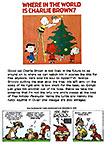
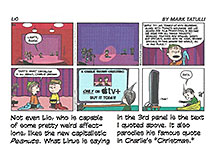
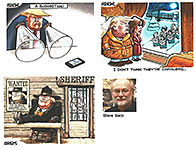
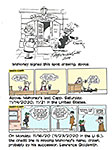
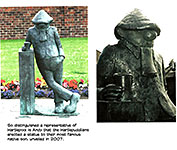

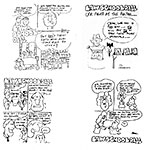
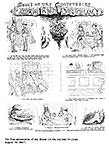

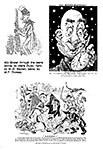
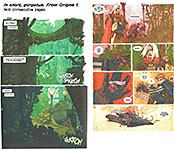
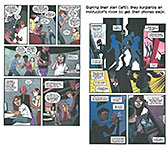
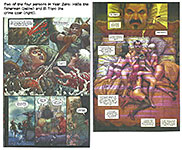
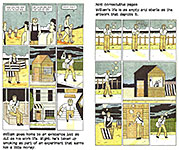
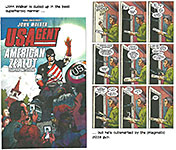
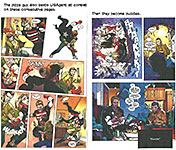
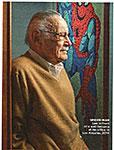
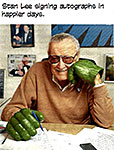
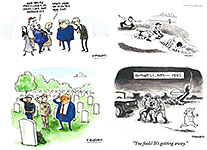
Covers.jpg)
1.jpg)
2.jpg)
3.jpg)
4.jpg)
5.jpg)
1.jpg)
2.jpg)
3.jpg)
4.jpg)
5.jpg)
6.jpg)
7.jpg)
8.jpg)
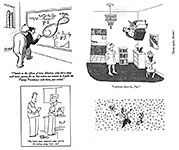
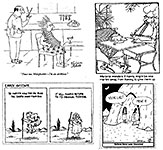
9.jpg)
10.jpg)
11.jpg)
12.jpg)
13.jpg)
14.jpg)
15.jpg)
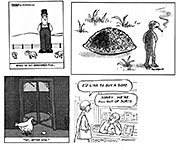

16.jpg)
17.jpg)
18.jpg)
19.jpg)
20.jpg)
21.jpg)
22.jpg)
23.jpg)
24.jpg)
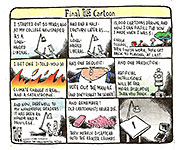
1.jpg)
2.jpg)
3.jpg)
4.jpg)
5.jpg)
6.jpg)

